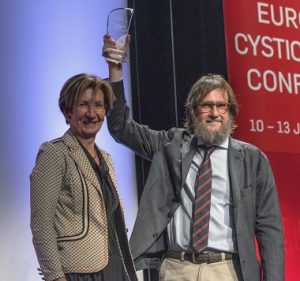GENETICS
FIRST SECTION – GENERAL, GENETIC INFLUENCES, RACIAL INFLUENCES
General – genetic influences, genotype-phenotype, varied response to CFTR modulators, CF in various countries, gene discovery on diagnosis, counselling and preventive therapy
SECOND SECTION – ANIMAL MODELS (MICE, PIGS, FERRETS)
FIRST SECTION
1944 Howard PJ. Familial character of fibrocystic disease of the pancreas. Am J Dis Child 1944; 68:330-332.
Philip Howard of Detroit reviewed the previous twelve instances of fibrocystic disease of the pancreas where a familial occurrence had been reported including instances where both or only one of twins had been affected. He reported an unusual number of infant deaths in two families in which proven CF existed and suggested the family furnished an instance of heterozygous inheritance (see Andersen and Hodges, 1946 below).
– This is the first suggestion that CF was an inherited disorder – later this was established by Andersen and Hodges (1946 below)
1944 Fanconi G, Botsztejn A. Familial pancreatic fibrosis with bronchiectasis. Schweiz Med Wchnschr 1944; 74:85. (German).
Fanconi’s 1936 report is considered by some Europeans to be the first clear description of cystic fibrosis (Fanconi et al, 1936 above). Here the authors described the family trees of 25 children with fibrocystic disease of the pancreas. They considered, incorrectly at it turned out, that recessive transmission was unlikely as there was consanguinity in only 3 of their cases and the proportion of affected siblings appeared too high. So they postulated the cause to be an early intrauterine toxic factor akin to haemolytic disease of the newborn.
– Andersen & Hodges, 1946 (below) were the first to correctly identify the Mendelian recessive mode of transmission, although a heterozygous mode had been suggested as likely by Howard in 1944 (above).
1945 Wissler H, Zollinger HU. Familial congenital cystic fibrosis of pancreas with bronchiectasis. Helv Paediatr Acta 1945; 1 (Suppl 1):3-88.
This paper from Zurich describes the clinical and pathological features of CF noting that lung changes may be absent in “nurslings with pancreatic fibrosis who die early”. The cystic pancreatic changes often are only detected by microscopy and may be overlooked. “It seems highly probable that the inflammatory changes in the pancreas, biliary passages and bronchial walls are the result of a single process… probably due to intrauterine damage of maternal origin… no reasons for accepting a primary avitaminosis as the cause and a recessive hereditary disease is improbable”.
– These Swiss authors mistakenly considered an hereditary cause of CF to be unlikely and suggested the cause was more likely due to intrauterine damage as had Fanconi & Botsztejn, 1944 (above).
1946 Andersen DH, Hodges RC. Celiac syndrome V. Genetics of cystic fibrosis of the pancreas with consideration of the etiology. Am J Dis Child 1946; 72:62-80.

Dorothy Andersen
Investigating 47 of their own families and 56 from the literature, the authors concluded that the familial incidence indicated a hereditary disorder with a recessive mode of inheritance, but which required more than one factor for its expression. Although the incidence in siblings approximates to the 25% expected of a Mendelian recessive trait, the authors observed that an hereditary condition requires more than one factor for its expression.
– This was a quite different explanation to that given by Fanconi et al (1944) but in line with that of Bodian, 1952 (below). Andersen continued to believe that “the pulmonary infection is the result of the nutritional deficiency” – obviously she considered this to be the additional factor required.
This is the first clear statement, backed by clinical evidence, that CF is inherited in a Mendelian recessive manner. Others, including David Lawson in the UK, would also speculate on the relative contribution of the basic defect and the secondary effects of the defect (such as chest infections and malnutrition) to the ultimate outlook for the patient. i.e. if the secondary effects could be prevented would the outlook be much better? Subsequent progress showed that this was indeed the case in view of the steady improvement in outlook that occurred before modification of the basic defect was achieved.
1949 Lowe CU, May CD, Reed SC. Fibrosis of pancreas in infants and children: statistical study of clinical and hereditary features. Am J Dis Child 1949; 78:349-374. [PubMed]
These authors from the University of Minnesota reviewed the hereditary aspects of 134 patients with CF seen over 10 years at the Infant’s and Children’s Hospital, Boston where previously May had worked. There were 118 sibships and the authors concluded that the condition was determined by a recessive gene as had Andersen and Hodges (Andersen & Hodges, 1946 above). They noted good weight gain before first symptoms and fair gains thereafter in those who survived. In discussing the clinical features they noted 44 children showed osteoporosis and retarded bone age. They questioned the importance of vitamin A deficiency in the pathogenesis as had others.
This is one of the earliest mentions of osteoporosis in people with CF – a complication that was to become a major problem for adults with CF in the years to come.
1952 Bodian ML. Fibrocystic Disease of the Pancreas. A Congenital Disorder of Mucus Production (Mucosis). London, W Heinemann, 1952.

Martin Bodian
The first substantial work on CF from the UK by Martin Bodian and his colleagues at the Hospital for Sick Children, Great Ormond Street, London (GOS). Dr. Martin Bodian (1910-1963), had been appointed morbid anatomist at GOS in 1946. Dr Archie Norman was the paediatrician in charge of the CF clinic at GOS and a leading figure in CF care in the UK for many years. Dr. Cedric Carter (1917-1984) was a clinical geneticist who started the first genetic counselling clinic at GOS in 1957.
In the preface of the book Martin Bodian notes the contents encompass almost a decade of work since Donald Paterson diagnosed the first child with CF at Great Ormond Street in 1943. The authors reviewed their own and previously published families and concluded there was a recessive mode of inheritance and suggested parents of a child with CF should be given a 1 in 4 risk of further children being affected; this confirmed the findings of Andersen & Hodges (1946 above) and the earlier suggestion of Howard (1944 above).
1962 Pileggi A. Cystic Fibrosis in a negro. Del Med J 1962; March:97-98.[PubMed]
A black infant admitted with bronchopneumonia at 8 months was diagnosed by three positive sweat tests as having cystic fibrosis. He died after 37 days. At autopsy, in addition to bronchopneumonia, the pancreas showed typical changes of cystic fibrosis. The authors note that at the Babies Hospital New York only 2 children of 397 cases were Negroes – an incidence of approximately 0.5% (di Sant’Agnese Am J Med 1956; 21:406).
1963 Batten J, Mir D, Simon G, Carter C. The prevalence of respiratory disease in heterozygotes for the gene for fibrocystic disease of the pancreas. Lancet 1963; i: 1348-1350. [PubMed]

Sir John Batten
The incidence of chronic bronchitis in parents of people with CF (obligate heterozygotes) and controls was similar to that reported for the general population – which was remarkably high at that time being 17% of men aged 40-60 years and 8% in women. The authors concluded that “the heterozygous state for fibrocystic disease of the pancreas could not be implicated as an important cause of chronic chest disease or of peptic ulceration”. These results agreed with those of Anderson et al. (Med J Aust 1962; 1:965).
These results may not apply today as chronic bronchitis was remarkably common in the general population then due to atmospheric pollution and tobacco smoking.
1968 Harries RL, Riley HD Jr. Cystic fibrosis in the American Indian. Pediatr 1968; 41:733-738.
These were the first two children with CF in the American Indian population. Both patients had convincingly high sweat tests and clinical features and were three years eight months and one year 11 months when reported. A sibling of case one who died had the typical pancreatic changes of cystic fibrosis. Caucasian ancestry, if present, was very distant and only on one side of the family and then three generations back. It was suggested that the rarity of CF in Mongolian and American Indians may be related to their common Asian ancestry before the American Indians crossed the Bering Straits into the Western Hemisphere. [PubMed]
1968 Bhakoo ON, Kumar R, Walia BN. Mucoviscidosis of lung. Report of a case. Indian J Pediatr 1968; 35: 183-185. [PubMed]
1968 Mehta S, Wadhwa UN, Mehta SK, Chhutani PN. Fibrocystic disease of the pancreas in India. Indian Pediatr 1968; 5:185-191. [PubMed]
First two reports of cystic fibrosis in India. Reviewed by Kabra SK et al (Cystic fibrosis in India. Pediatr Pulmonol 2007; 42:1087-1094.) [PubMed]
1974 Kulczycki LL, Schauf V. Cystic fibrosis in blacks in Washington DC. Am J Dis Child 1974; 127:64-67. [PubMed]
An intensive search for black people CF between 1962 to 1971 revealed 16 with cystic fibrosis. The clinical course was similar to the condition in whites. The calculated incidence was estimated as at least one in 17,033 black newborns. Later these findings were confirmed by others. More recently African mutations have been described by Michelle Ramsay and colleagues in South Africa (Carles et al, 1996 below).
1995 Gan K-H, Geus WP, Bakker W, Lamers CBHW, Heijerman HGM. Genetic and clinical features of patients with cystic fibrosis diagnosis after the age of 16 years. Thorax 1995; 50:1301-1304.[PubMed]
Predictably, adult patients with late diagnosis have a better prognosis. The differences between the early diagnosis of 4.6 years (ED) and late diagnosis 27.7 years (LD) were FEV1 52% vs 72.5%; Pseudomonas infection in 70% vs 24%; pancreatic insufficiency 81% vs 12%; homozygous for DF508 58% vs none.
– In other series of adults with CF many have been diagnosed late and had other features suggesting many had milder mutations – supported by the high frequency of pancreatic sufficiency. However, it has been emphasised that these patients require just as careful follow up and treatment as those with the more usual clinical picture – rather than waiting until they develop more obvious chest symptoms (Lording A, et al. Pulmonary infection in mild variant cystic fibrosis: implications for care. J Cyst Fibros 2006; 5:101-104.[PubMed]).
1995 Gan K H, Veeze HJ, van den Ouweland AM, Halley DJ, Scheffer H, van der Hout, A, Overbeek SE, de Jongste JC, Bakker W, Heijerman HG. A cystic fibrosis mutation associated with mild lung disease. New Eng J Med 1995; 333:95-99.[PubMed
Among Dutch patients A455E the second most common mutation and associated with preserved pancreatic function and some residual secretion of chloride across membranes. Thirty three patients with compound heterozygosity for the A455E mutation were compared with matched controls homozygous for the delta F508 mutation. In those with the A455E mutation diagnosis was later (mean age at diagnosis, 15.0 vs. 3.1 years; P < 0.001); fewer had pancreatic insufficiency (21.2 percent vs. 93.9 percent, P < 0.001), and none had diabetes mellitus (0 percent vs. 27.3 percent, P = 0.004). FEV1 and FVC were significantly higher (FEV1, 73.9 vs. 54.3 % predicted P = 0.002) and FVC, 88.7 vs. 76.3 % predicted P = 0.04). Fewer had chronic pseudomonas infection (33.3 vs. 60.6 % P = 0.02). Although several mutations were known to be associated with less severe pancreatic disease, these findings showed a correlation between the A455E mutation and mild pulmonary disease resulting in a better prognosis than patients homozygous for the df508.

Harry Heijerman
Dr Harry Heijerman was the Founding Editor of the Journal of Cystic Fibrosis. Under his guidance the journal was increasingly successful; the editorship was taken over by Prof. Gerd Döring in 2006 (see 2002 Journal of Cystic Fibrosis below). Gerd died in 2013 and the editorship passed to Scott Bell. Harry Heijerman is Physician at Haga Teaching Hospital, Deb Haag in the Netherlands and a leading figure in CF care and research in Europe.
1996 Carles S, Desgeorges M, Goldman A, Thiart R, Guittard C, Kitazos CA, de Ravel TJ, Westwood AT, Claustres M, Ramsay M. First report of CFTR mutations in black cystic fibrosis patients of southern African origin. J Med Genet 1996; 33:802-804. [PubMed]
Cystic fibrosis was thought to be rare in the black populations of Africa and only a few patients have been reported but they had not been studied at the molecular level. This report, from Michelle Ramsay’s laboratory, concerns the detection of CFTR mutations in three black South African patients. One was homozygous for the 3120 + 1G–>A mutation, while the other two were compound heterozygotes each with this mutation on one chromosome. The other mutations were G1249E and a previously unreported in frame 54 bp deletions within exon 17a involving nucleotides 3196-3249 (3196del54).
– The 3120 + 1G–>A mutation was first described in black American patients and has been shown to be a relatively common mutation in this population (9-14% of CF chromosomes). It was also found in a black CF patient whose father, the 3120 + 1G–>A carrier, is from Cameroon. These data suggest that it is an old mutation which accounts for many of the CFTR mutations in black Africans (Also Pileggi A. 1962; Kulczycki LL et al, 1964 above and other reports find a low incidence in black patients).
1997 Loirat F, Hazout S, Lucotte G. G542X as a probable Phoenician cystic fibrosis mutation. Hum Biol 1997; 69:419-425. [PubMed] When analysed by origin, the frequency of the G542X CF mutation (the second most common CF mutation in Europe after DF508) varies between population groups in Europe being lower in north-eastern Europeans than in south-western Europeans. The more elevated values of G542X frequency correspond to ancient sites of occupation by occidental Phoenicians. N1303K as been linked to ancient Mediterranean populations and G551D associated with ancient Celtic tribes (Cashman SM et al, Hum Hered 1995; 45:6-12. [PubMed]).
2000 Kostuch M, Semczuk A, Szarewicz-Adamczyk W, Gasowska-Giszczak U, Wojcierowski J, Kulczycki L. Detection of CFTR gene mutations in patients suffering from chronic bronchitis. Arch Med Res 2000; 31: 97-100. [PubMed]
The purpose of this study from Poland was to search for CF gene mutations in patients suffering from chronic bronchitis. No less than five of 32 (16%) patients admitted to the Lublin School of Medicine, Poland between 1995 and 1996 with chronic bronchitis had CF gene mutations, all within the DeltaF508 region of the CFTR gene. All positive samples were obtained from patients heterozygous for the DeltaF508 mutation. The presence of the DeltaF508 mutation was considered statistically significant when the study group was compared to the study of Poland’s general population. The results suggested an increased presence of the DeltaF508 mutation in Polish patients suffering from chronic bronchitis.
– Earlier clinical studies using sweat tests from the UK did not show people with unrecognised or mild CF were present among patients considered to have chronic bronchitis (Muir D et al. 1962). Also in another study, perhaps more relevant to the present report, there was no increase in the frequency of chronic bronchitis among obligate CF heterozygotes (Batten et al, 1963). However, the prevalence of chronic bronchitis was very high in the UK general population at that time (presumably due to the high proportion of smokers and atmospheric pollution) and this may have obscured the influence of the CF carrier state. More recently complete mutational screening of 120 patients with chronic pulmonary disease detected mutations in 11/23 disseminated bronchiectasis, 7/25 emphysema, 5/27 chronic bronchitis, 5/26 lung cancer, 5/8 sarcoidosis (Bombieri et al, 1998. [PubMed]). In a more recent study 17.74% of 31 patients with chronic obstructive pulmonary disease had a CFTR mutation (Divac et al, 2004). [PubMed] Although others searching for only the six common mutations found no increase in CFTR mutations in 100 patients with chronic bronchitis (Entzian P et al, 1995). [PubMed]. However, 5/11 non-CF individuals who had allergic bronchopulmonary aspergillosis (ABPA) had one CFTR mutation (Miller PW et al, 1996. [PubMed]). Also CFTR function has been reported as significantly depressed in smokers (Cantin AM et al. Am J Resp Crit Care Med 2006; 173:1139-1144). [PubMed]
2000 Mickle JE, Cutting GR. Genotype-phenotype relationships in cystic fibrosis. Med Clin North Am 2000; 84:597-607. [PubMed]

Garry Cutting
The fact that variability is observed among people with the “classic” form of CF is evidence that other factors are important. The so-called “mild mutations” that allow partial function of CFTR are often associated with pancreatic sufficiency, occasionally identified with normal sweat gland function, and sporadically correlated with mild lung disease; also partially functioning mutants rarely prevent maldevelopment of the male reproductive tract; an exception is 3849 + 10 Kb C–>T.
– These observations suggest that certain tissues require different levels of CFTR function to avoid the pathologic manifestations typical of CF. However; It is still true that, in the majority of patients, the outlook is more dependent on the standard of treatment the patient receives and whether that treatment is started before there is irreversible lung damage.
2000 Mekus F, Ballman M, Bronsveld I, Bijman J, Veeze H, Tummler B. Categories of DF508 homozygous cystic fibrosis twin and sibling pairs with distinct phenotypic characteristics. Twin Res 2000; 3:277-293. [PubMed]

Burkhard Tummler.
A large European twin study searching for features for which the twins were discordant. Monozygotic twins with CF had less discordance than dizygotic twins indicating that, in part, CF severity is modulated by an inherited component in addition to the CFTR itself and the very important environmental factors.
Although there was increasing interest in the effect of modifying genes that affected the course of CF in affected individuals, in practical terms the influence of most was relatively small when compared with the influence of the standard of treatment the patient received.
Professor Ballman is based in the Paediatric Department and CF Centre in Hanover, Germany and involved in national and international CF matters.
2001 Iwasa S, Fujiwara M, Nagata M, Watanabe T. Three autopsied cases of cystic fibrosis in Japan. Pathol Internat 2001; 51:467-472. [PubMed]
The incidence of CF is very low in the Japanese. All three patients initially developed meconium ileus, and hepatobiliary and pancreatic changes became more severe as age increased. None had the DeltaF508 mutation. The authors reviewed 22 Japanese autopsied cases of CF in the literature. They suggested that the high incidence of meconium ileus in Japanese CF patients may relate to a clinically severe phenotype and reflect a different genetic background between Caucasians and Japanese. The incidence of CF in Japanese had been estimated previously at 1:350,000 considering 104 reported cases in 1997 (Yamashiro Y et al, 1997; 24:544-547. [PubMed]; also Nishimori I, Onishi S. Hereditary pancreatitis in Japan: a review of pancreatitis-associated gene mutations. Pancreatology 2001; 1:444-447. [PubMed]).
2001 Goldman A, Labrum R, Claustres M, Desgeorges M, Guittard C, Wallace A, Ramsay M. The molecular basis of cystic fibrosis in South Africa. Clin Genet 2001; 59:37-41. [PubMed]

Michelle Ramsay
The spectrum of CFTR mutations in three South African populations is presented. To date. a total of 192 white patients (384 chromosomes) with confirmed CF have been tested. deltaF508 accounts for 76% of the CF chromosomes in this group, with 3272-26A–>G, 394delTT and G542X occurring at the following frequencies: 4, 3.6 and 1.3%, respectively. A further 11 mutations account for 6% of CF chromosomes. A total of 91% of the CF-causing mutations can now be detected in the South African white population. Haplotype analysis suggests a founder effect in South Africans of European origin for the two common CFTR mutations, 3272-26A–>G and 394delTT. The diagnosis of CF has been confirmed in 14 coloured and 12 black CF patients. In the coloured population, both the deltaF508 and 3120 + 1G–>A mutations occur at appreciable frequencies of 43 and 29%, respectively. In the black population, the most common CF-causing mutation, the 3120 + 1G–>A mutation, occurs at an estimated frequency of 46%. Four other mutations have been detected, resulting in the identification of a total of 62.5% of mutations in this population.
An interesting paper from Michelle Ramsay’s department in South Africa documenting the mutations found in the coloured and black populations.
2002 Bobadilla JL, Macek M, Fine JP, Farrell PM. Cystic fibrosis: A worldwide analysis of CFTR mutations – correlation with incidence data and application to screening. Hum Mutat 2002; 19:575-606. [PubMed]
The results confirmed wide mutational heterogeneity throughout the world. They also examined CF incidence, DeltaF508 frequency, and regional mutational heterogeneity in a subset of populations and there is a significant positive correlation between DeltaF508 frequency and the CF incidence levels of regional populations. Regional analyses were also performed to search for trends in the distribution of CFTR mutations across migrant and related populations; this led to clarification of ancestry-genotype patterns that can be used to design CFTR multi-mutation panels for CF screening programs.
– This is an immense study bringing together all the information from over 100 published papers to achieve a global understanding of the population molecular genetics associated with CF in an effort to increase understanding of ancestry-genotype relationships, to compare mutational arrays with incidence and to gain insight for decisions regarding screening program enhancement through CFTR mutational analysis.
2003 Li N, He B, Wang GF, Tang XY. A case report of cystic fibrosis and review of 16 cases of cystic fibrosis in Chinese patients. [Chinese] Chinese Journal of Tuberculosis & Respiratory Diseases 2003; 26:559-562. [PubMed].
A 14-year-old Chinese girl presenting with recurrent productive cough since birth with parasinusitis and otitis media was confirmed to have CF in Peking University First Hospital. Chest CT scan showed bronchiectasis, more severe in the right upper lobe. Sweat tests were taken three times, and the values of Na(+) and Cl(-) were (126.6 +/- 5.4) mmol/L and (108.9 +/- 3.3) mmol/L, respectively. The examination of the pancreas showed no remarkable cystic changes on CT scan and there was no pancreatic insufficiency. Sixteen patients with CF in Chinese reported from 1974 to 1999 were reviewed. Sixteen of the 17 patients (7 males and 9 females, aged from 6 months to 25 years) had clinical data available for analysis. Eleven of them had died, nine before the age of 13. They all suffered from frequent episodes of pneumonia, while 14 had malnutrition and 4 had jaundice. The diagnostic procedures included clinical features, sweat test and autopsy. Four of them had DNA screened and four kinds of novel mutations in the cystic fibrosis transmembrane conductance regulator gene were found.
– So Chinese patients with CF show similar clinical manifestations to patients in the European and North American populations, but the CFTR mutation was different. (See also Li N et al,2006).
2003 Frangolias DD, Ruan J, Wilcox PJ, Davidson AG, Wong LT, Berthiaume Y, Hennessey R, Freitag A, Pedder L, Corey M, Sweezey N, Zielenski J, Tullis E., Sandford AJ. Alpha 1-antitrypsin deficiency alleles in cystic fibrosis lung disease. Am J Resp Cell Mol 2003; 293):390-396.[PubMed]
The conclusions of this detailed study were that alpha1-AT genotype is not a major contributor to the variability of pulmonary disease severity in cystic fibrosis.
2005 Drumm ML, Konstan MW, Schluchter MD, Handler A, Pace R, Zou F, Zariwala M, Fargo D, Xu A, Dunn JM, Darrah RJ, Dorfman R, Sandford AJ, Corey M, Zielenski J, Durie P, Goddard K, Yankaskas JR, Wright FA, Knowles MR. Gene Modifier Study Group. Genetic modifiers of lung disease in cystic fibrosis. N Eng J Med 2005; 353:1443-1453. [PubMed]
Polymorphisms in genes other than the CFTR gene may modify the severity of pulmonary disease in patients with cystic fibrosis. 808 patients who were homozygous for the DeltaF508 mutation had either severe or mild lung disease (i.e. they were in the lowest or highest quartiles for FEV1). The authors genotyped 16 polymorphisms in 10 genes that had been reported by others as modifiers of disease severity in CF and tested for an association in the patients with severe disease (263 patients) or mild disease (545). In a second study, of 498 patients, with various CFTR genotypes and a range of FEV1 values, they tested for an association of the TGFbeta1 codon 10 CC genotype with low FEV1.
– In the first study, significant allelic and genotypic associations with phenotype were seen only for TGFbeta1 (the gene encoding transforming growth factor beta1). The second study confirmed the association of the TGFbeta1 codon 10 CC genotype with more severe lung disease.
2006 McKone EF, Goss CH, Aitkin ML. CFTR genotype as a predictor of prognosis in cystic fibrosis. Chest 2006; 130:1441-1447. [PubMed]
Data from CF Foundation registry on 15,651 patients was analysed and showed that the “high risk” CFTR genotype carried a twofold increased risk of death compared to those with “low risk” genotype. Of patients who died, high risk median age of death 24.2 years and low risk 37.6 years. Most reassurance can be provided for patients in the low risk group although there is substantial phenotypic variability.
– The outlook for people with CF is mainly determined by the treatment they receive although a small number certainly do have mutations which are associated with milder disease, often associated with pancreatic sufficiency and a much later presentation and diagnosis.
2006 Li N, Pei P, Bu DF, He B, Wang GF. A novel CFTR mutation found in a Chinese patient with cystic fibrosis. Chin Med J 2006; 119:103-109. [PubMed]
A Chinese girl of 16 years old was diagnosed as having CF at the age of 14 years. A heterozygous novel missense mutation of 699 C –> A, which results in the amino acid change of N189K, was identified in exon 5. In addition, a heterozygous 3821 – 3823 delT mutation in exon 19 was found in CFTR.
– CF is very rare on Chinese people; only twenty were reported from 1974 to 2004 were also reviewed in this paper. DelF508 mutation was not found in any of the nine cases whose CFTR mutations were analyzed and suggests that the genotype of Chinese CF may be different from those in Europe and N America.
2006 Ziedalski TM, Kao PN, Henig NR, Jacobs SS, Ruoss SJ. Prospective analysis of cystic fibrosis transmembrane regulator mutations in adults with bronchiectasis or pulmonary nontuberculous mycobacterial infection. Chest 2006; 130:995-1002.[PubMed]
Fifty adult patients at Stanford University Medical Center with a diagnosis of bronchiectasis and/or pulmonary NTM infection were prospectively characterized by sweat chloride measurement, comprehensive mutational analysis of CFTR, and sputum culture results.
A new diagnosis of cystic fibrosis (CF) was established in 10 patients (20%). Sweat chloride concentration was elevated > 60 mEq/dL (diagnostic of CF) in seven patients (14%), and from 40 to 60 mEq/dL in eight patients (16%). The frequency of CFTR mutations was elevated above that expected in the general population: heterozygous DeltaF508 (12% vs 3%), R75Q (14% vs 1%), and intron 8 5T (17% vs 5 to 10%).
2008 Castellani C, Cuppens H, Macek M Jr, Cassiman JJ, Kerem E, Durie P, Tullis E, Assael BM, Bombieri C, Brown A, Casals T, Claustres M, Cutting GR, Dequeker E, Dodge J, Doull I, Farrell P, Ferec C, Girodon E, Johannesson M, Kerem B, Knowles M, Munck A, Pignatti PF, Radojkovic D, Rizzotti P, Schwarz M, Stuhrmann M, Tzetis M, Zielenski J, Elborn JS. Consensus on the use and interpretation of cystic fibrosis mutation analysis in clinical practice. J Cyst Fibros 2008; 7:179-196. [PubMed]

Carlo Castellani receiving the ECFS Award in 2015
It is often challenging for the clinician interested in cystic fibrosis (CF) to interpret molecular genetic results, and to integrate them in the diagnostic process. The limitations of genotyping technology, the choice of mutations to be tested, and the clinical context in which the test is administered can all influence how genetic information is interpreted. This paper describes the conclusions of a consensus conference to address the use and interpretation of CF mutation analysis in clinical settings. This is a major review by an international group of experts of the best way to use mutation analysis in cystic fibrosis.
2008 Douros K. Loukou I. Doudounakis S. Tzetis M. Priftis KN. Kanavakis E. Asthma and pulmonary function abnormalities in heterozygotes for cystic fibrosis transmembrane regulator gene mutations. Int j clin exp med 2008; 1:345-349. [PubMed]
The aim of this study is to evaluate the association between CFTR gene mutations with asthma and pulmonary function abnormalities. For this purpose, 214 mutation carriers were compared to 185 non-carriers. Although the relative risk of asthma did not differ between groups (OR=0.61, 95% CI: 0.23-1.61, p=0.32), the values of FEV1, and FEV1/FVC ratio were lower in carriers (p=0.001, and p<0.001, respectively).
The authors suggested that this may imply that heterozygosity may be related with a silent obstructive pulmonary profile.
2009 Dequeker E, Stuhrmann M, Morris MA, Casals T, Castellani C, Claustres M, et al. Best practice guidelines for molecular genetic diagnosis of cystic fibrosis and CFTR-related disorders – updated European recommendations. Eur J Hun Genet 2009; 17:51-65.
An increasing number of laboratories offering molecular genetic analysis of the CFTR gene and the growing use of commercial kits strengthen the need for an update of previous best practice guidelines (published in 2000). The importance of organizing regional or national laboratory networks, to provide both primary and comprehensive CFTR mutation screening, is stressed. Current guidelines focus on strategies for dealing with increasingly complex situations of CFTR testing. Diagnostic flow charts now include testing in CFTR-related disorders and in fetal bowel anomalies. Emphasis is also placed on the need to consider ethnic or geographic origins of patients and individuals, on basic principles of risk calculation and on the importance of providing accurate laboratory reports. Finally, classification of CFTR mutations is reviewed, with regard to their relevance to pathogenicity and to genetic counselling.
2009 Bartlett JR, Friedman KJ, Ling SC, et al. Gene Modifier Study Group. Genetic modifiers of liver disease in cystic fibrosis. JAMA 2009; 302:1076-1083. [PubMed]
A subset (approximately 3%-5%) of patients with CF develops severe liver disease with portal hypertension. The objective of the study was to assess whether any of 9 polymorphisms in 5 candidate genes (alpha(1)-antitrypsin or alpha(1)-antiprotease [SERPINA1], angiotensin-converting enzyme [ACE], glutathione S-transferase [GSTP1], mannose-binding lectin 2 [MBL2], and transforming growth factor beta1 [TGFB1]) are associated with severe liver disease in patients with CF.
The authors concluded that the SERPINA1 Z allele is a risk factor for liver disease in CF. Patients who carry the Z allele are at greater risk (OR, approximately 5) of developing severe liver disease with portal hypertension.
2009 Thauvin-Robinet C. Munck A. Huet F. Génin E. Bellis G. Gautier E. et al. Collaborating Working Group on R117H.The very low penetrance of cystic fibrosis for the R117H mutation: a reappraisal for genetic counselling and newborn screening. J Med Genet 2009; 46:752-758.[PubMed]
Phenotypic variability associated with certain mutations makes genetic counselling difficult, notably for R117H, whose disease phenotype varies from asymptomatic to classical CF. The high frequency of R117H observed in CF newborn screening has also introduced diagnostic dilemmas. The aim of this study was to evaluate the disease penetrance for R117H in order to improve clinical practice.
The phenotypes in all individuals identified in France as compound heterozygous for R117H and F508del, the most frequent CF mutation, were described. The allelic prevalences of R117H (p(R117H)), on either intron 8 T5 or T7 background, and F508del (p(F508del)) were determined in the French population, to permit an evaluation of the penetrance of CF for the [R117H]+[F508del] genotype. Clinical details were documented for 184 [R117H]+[F508del] individuals, including 72 newborns.
The disease phenotype was predominantly mild; one child had classical CF, and three adults’ severe pulmonary symptoms. In 5245 healthy adults, p(F508del) was 1.06%, p(R117H;T7) 0.27% and p(R117H;T5)<0.01%. The theoretical number of [R117H;T7]+[F508del] individuals in the French population was estimated at 3650, whereas only 112 were known with CF related symptoms (3.1%). The penetrance of classical CF for [R117H;T7]+[F508del] was estimated at 0.03% and that of severe CF in adulthood at 0.06%.
The authors suggest that these results suggest that R117H should be withdrawn from CF mutation panels used for screening programmes. They suggest real impact of so-called disease mutations should be assessed before including them in newborn or preconceptional carrier screening programmes.
2010 Spadafora D, Hawkins EC, Murphy KE, Clark LA, Ballard ST. Naturally occurring mutations in the canine CFTR gene. Physiol Genom 2010; 42:480-485. [PubMed]
Naturally occurring cystic fibrosis (CF)-causing mutations in the CFTR gene have not been identified in any non-human animal species. Since domestic dogs are known to develop medical conditions associated with atypical CF in humans (e. g. , bronchiectasis and pancreatitis), the authors hypothesized that dogs with these disorders are likely have a higher expression rate of CFTR mutations than the at-large population. Temporal temperature-gradient gel electrophoresis (TTGE) was used to screen canine CFTR in 400 animals: 203 dogs diagnosed with pancreatitis, 23 dogs diagnosed with bronchiectasis, and 174 dogs admitted to clinics for any illness (“at-large” dogs).
Twenty-eight dogs were identified with one of four CFTR missense mutations. P1281T and P1464H mutations occur in relatively unconserved residues. R1456W is analogous to the human R1453W mutation, which has approximately 20% of normal CFTR function and is associated with pancreatitis and panbronchiolitis. R812W disrupts a highly conserved protein kinase A recognition site within the regulatory domain.
The authors conclude that naturally occurring CFTR mutations are relatively common in domestic dogs and can be detected with TTGE. No substantive differences in mutation frequency were observed between the at-large, pancreatitis, and bronchiectasis dogs.
– This is of interest and CFTR mutations in dogs is a new but not particularly practical relevant finding. Impressive to collect so many “patients”. with these various disorders.
2011 Wright FA, Strug LJ, Doshi VK, Commander CW, Blackman SM, Sun L, Berthiaume Y, Cutler D, Cojocaru A, Collaco JM, Corey M, Dorfman R, Goddard K, Green D, Kent JW Jr, Lange EM, Lee S, Li W, Luo J, Mayhew GM, Naughton KM, Pace RG, Pare P, Rommens JM, Sandford A, Stonebraker JR, Sun W, Taylor C, Vanscoy LL, Zou F, Blangero J, Zielenski J, O’Neal WK, Drumm ML, Durie PR, Knowles MR, Cutting GR. Genome-wide association and linkage identify modifier loci of lung disease severity in cystic fibrosis at 11p13 and 20q13.2. Nat Genet 2011; 43:539-546. [PubMed]
A combined genome-wide association and linkage study was used to identify loci causing variation in cystic fibrosis lung disease severity. The authors identified a significant association (P = 3.34 x 10(-8)) near EHF and APIP (chr11p13) in p.Phe508del homozygotes (n = 1,978). The association replicated in p.Phe508del homozygotes (P = 0.006) from a separate family based study (n = 557), with P = 1.49 x 10(-9) for the three-study joint meta-analysis. Linkage analysis of 486 sibling pairs from the family based study identified a significant quantitative trait locus on chromosome 20q13.2 (log(10) odds = 5.03). These findings provide insight into the causes of variation in lung disease severity in cystic fibrosis and suggest new therapeutic targets for this life-limiting disorder.
– A number of studies have searched for genetic modifiers of the severity of CF. This is one such study although it is not clear how this knowledge will be used as a therapeutic target unless by modifying the locus described. Undoubtedly in 2014 the standard of treatment received during childhood and subsequently seems to be the most important factor in determining the patient’s condition and ultimate survival.
2013 Tsui LC. Dorfman R. The cystic fibrosis gene: a molecular genetic perspective. [Review] Cold Spring Harbor Perspectives in Medicine 2013; 3(2):a009472. Free Download available[PubMed]

Lap Chee
Tsui
The positional cloning of the gene responsible for cystic fibrosis (CF) was the important first step in understanding the basic defect and pathophysiology of the disease. This study aims to provide a historical account of key developments as well as factors that contributed to the cystic fibrosis transmembrane conductance regulator (CFTR) gene identification work.
A redefined gene structure based on the full sequence of the gene derived from the Human Genome Project is presented, along with brief reviews of the transcription regulatory sequences for the CFTR gene, the role of mRNA splicing in gene regulation and CF disease, and, various related sequences in the human genome and other species. Because CF mutations and genotype-phenotype correlations are covered by our colleagues (Ferec C, Cutting GR. 2012. Assessing the disease-liability of mutations in CFTR. Cold Spring Harb Perspect Med doi: 10.1101/cshperspect.a009480), the authors only attempt to provide an introduction of the CF mutation database here for reference purposes.
2016 Tian X; Liu Y; Yang J; Wang H; Liu T; Xu W; Li X; Zhu Y; Xu KF; Zhang X. p.G970D is the most frequent CFTR mutation in Chinese patients with cystic fibrosis. Human Genome Variation. 3:15063, 2016. [PubMed]
The authors previously identified CFTR mutations in 20 Chinese patients with CF. In this study, eight Chinese patients with a clinical diagnosis of suspected CF were newly collected and screened for CFTR mutations using a combination of conventional Sanger sequencing and multiplex ligation-dependent probe amplification (MLPA) analysis. The CFTR mutations observed in Chinese CF patients, both reported previously and identified in the present study, were also summarised. In the newly collected patients, they identified 10 different CFTR mutations, including p.F508del, the most common CF-causing mutation in Caucasians, and three novel mutations (p.V1212Afs*15; p.L666* and p.A969A). Most notably, the previously reported p.G970D mutation was found in six patients, making it the most frequent CFTR mutation identified in Chinese CF patients thus far. They detected p.F508del for the first time, identified additional novel CFTR mutations and recorded the most frequent CF-causing mutation in Chinese CF patients.
2016 Shen Y; Liu J; Zhong L; Mogayzel PJ Jr; Zeitlin PL; Sosnay PR; Zhao S. Clinical Phenotypes and Genotypic Spectrum of Cystic Fibrosis in Chinese Children. J Pediatr 2016; 171:269-76. [PubMed]
The authors recruited and characterized the phenotypes of 21 Chinese children with CF. All 27 exons and their flanking sequences of the CF transmembrane conductance regulator gene were amplified and sequenced to define the genotypes. RESULTS: Bronchiectasis (95.2%) and sinusitis (76.2%) were the most common clinical presentations among our patients. By contrast, pancreatic insufficiency was rare (14.3%). The predominant organism found in the airways was Pseudomonas aeruginosa (66.7%). There were obvious reductions of forced expiratory volume in the first second (mean +/- SD: 71.8% +/- 17.2% predicted) and forced expiratory flows at 75% of exhaled vital capacity (33.7% +/- 20.4% predicted) in children with CF. Overall, we identified 22 different mutations, including 12 missense, 5 nonsense, 2 frameshift, 1 in-frame insertion, 1 splice site, and 1 3’untranslated region mutation. Of these, 7 were novel observations (W216X[780G->A], 1092insA, Q359X, D567Y, 2623-126T->C, 3439delA and 4575+110C->G), and the most common types were L88X and I556V. One de novo mutation (1092insA) was also revealed. Except for N1303K and R334W, none of them were present in the common Caucasian CF transmembrane conductance regulator mutation-screening panels.There was a 5.7-year delay between the first clinical presentation and the eventual CF diagnosis, suggesting that CF may be under-diagnosed in China. The clinical phenotypes and genotypic spectrum are different from that observed in Caucasians.
– The rarity of CF in China presumably is one factor accounting for the delay in eventual diagnosis.
Saavedra MT, Quon BS, Faino A, Caceres SM, Poch KR, Sanders LA, Malcolm KC, Nichols DP, Sagel SD, Taylor-Cousar JL, Leach SM, Strand M, Nick JA.Whole Blood Gene Expression Profiling Predicts Severe Morbidity and Mortality in Cystic Fibrosis: A 5-Year Follow-Up Study. Ann Am Thorac Soc. 2018 May;15(5):589-598. doi: 10.1513/AnnalsATS.201707-527OC. [Pubmed]

Milene Saavendra
Cystic fibrosis pulmonary exacerbations accelerate pulmonary decline and increase mortality. Previously, we identified a 10-gene leukocyte panel measured directly from whole blood, which indicates response to exacerbation treatment. We hypothesized that molecular characteristics of exacerbations could also predict future disease severit
The authors tested whether a 10-gene panel measured from whole blood could identify patient cohorts at increased risk for severe morbidity and mortality, beyond standard clinical measures. Transcript abundance for the 10-gene panel was measured from whole blood at the beginning of exacerbation treatment (n = 57). A hierarchical cluster analysis of subjects based on their gene expression was performed, yielding four molecular clusters. An analysis of cluster membership and outcomes incorporating an independent cohort (n = 21) was completed to evaluate robustness of cluster partitioning of genes to predict severe morbidity and mortality
The four molecular clusters were analyzed for differences in forced expiratory volume in 1 second, C-reactive protein, return to baseline forced expiratory volume in 1 second after treatment, time to next exacerbation, and time to morbidity or mortality events (defined as lung transplant referral, lung transplant, intensive care unit admission for respiratory insufficiency, or death). Clustering based on gene expression discriminated between patient groups with significant differences in forced expiratory volume in 1 second, admission frequency, and overall morbidity and mortality. At 5 years, all subjects in cluster 1 (very low risk) were alive and well, whereas 90% of subjects in cluster 4 (high risk) had suffered a major event (P = 0.0001). In multivariable analysis, the ability of gene expression to predict clinical outcomes remained significant, despite adjustment for forced expiratory volume in 1 second, sex, and admission frequency. The robustness of gene clustering to categorize patients appropriately in terms of clinical characteristics, and short- and long-term clinical outcomes, remained consistent, even when adding in a secondary population with significantly different clinical outcomes.
The authors suggest whole blood gene expression profiling allows molecular classification of acute pulmonary exacerbations, beyond standard clinical measures, providing a predictive tool for identifying subjects at increased risk for mortality and disease progression.
Dr Milene T Saavendra is Associate Professor and pulmonologist, Department of Medicine, University of Colorado, Denver.
See editorial below
Edmondson C, Davies JC. Predicting the Future of Cystic Fibrosis Lung Disease: Gene Expression Holds Some of the Answers. Ann Am Thorac Soc. 2018 May;15(5):556-557. doi: 10.1513/AnnalsATS.201802-098ED. [Pubmed] ( an editorial relating to the above article In an editorial relating to the paper of Saavendra et al.)

Claire Edmundson
The authors note that a predictive biomarker of pulmonary exacerbations (APE) would be very useful. They discuss work undertaken in this area by a number of groups. In 2013 some 78 blood based biomarkers had been explored – C-reactive protein being the only one used in clinical practice; even this had limitations. They note that Saavenra and colleagues identify 4 definite gene cluster groups at the start of an APE as described in their paper which it is hoped should provide additional information on outlook.
Dr. Claire Edmondson is a paediatric registrar at the Royal Brompton currently working for a PhD relating to digital monitoring of CF patients at home.
Professor Jane Davies is Senior Lecturer at Imperial College and Hon. Consultant in Paediatric Respiratory Medicine at The Royal Brompton, London. She is a leading UK authority on cystic fibrosis and a senior member of the UK Gene Therapy Consortium.
Pasterkamp H, Menzies KJ, Bayomi DJ .Cystic fibrosis in Canadian Hutterites. Pediatr Pulmonol. 2019 Nov 29. doi: 10.1002/ppul.24590. [Epub ahead of print][Pubmed]

Hans Pasterkamp
The Hutterite Brethren are a communal group of Anabaptists who live in the Western regions of North America, predominantly in the Western Canadian provinces. Due to a founder effect, Hutterites have a high rate of cystic fibrosis (CF) with genotypes limited to only two CFTR mutations. One-third of Hutterite patients with CF are pancreatic sufficient. Previously we found an unexplained younger age at death in Hutterites compared with nonHutterites homozygous for the common F508del mutation. The present study expanded the data collection and analysis for confirmation and further exploration
Anonymized information, based on Hutterite surnames, was extracted from the Canadian CF Registry. Summary data on nonHutterite patients with CF homozygous for F508del served as control. Statistical analyses explored the effects of genotype within Hutterites and compared nutritional status, lung function, and microbiologic findings between the groups.
The younger average age at death in Hutterites compared with controls was confirmed, but there was no suggestion of a generally shortened life expectancy. While the nutritional status in Hutterite children was better than that of controls, their lung function was slightly but significantly lower. Staphylococcus aureus was more frequent in Hutterites while there was no difference between the groups regarding Pseudomonas aeruginosa.
The authors concluded despite less pancreatic insufficiency, better nutrition, communal life in socioeconomic stability, and without exposure to environmental tobacco smoke, the clinical course of CF appears to be more severe in a significant number of Hutterites. Investigations of gene-environment interactions and of CF disease gene modifiers may help to explain this conundrum.
Dr Hans Pasterkamp is Professor Emeritus at the Department of Pediatrics and Child Health, University of Manitoba, Winnipeg, Canada.
Wakabayashi-Nakao K, Yu Y, Nakakuki M, Hwang TC, Ishiguro H, Sohma Y. Characterization of Δ(G970-T1122)-CFTR, the most frequent CFTR mutant identified in Japanese cystic fibrosis patients. J Physiol Sci. 2019 Jan;69(1):103-112. doi: 10.1007/s12576-018-0626-4. Epub 2018 Jun 27. [Pubmed]
A massive deletion over three exons 16-17b in the CFTR gene was identified in Japanese CF patients with the highest frequency (about 70% of Japanese CF patients definitely diagnosed). This pathogenic mutation results in a deletion of 153 amino acids from glycine at position 970 (G970) to threonine at 1122 (T1122) in the CFTR protein without a frameshift. We name it Δ(G970-T1122)-CFTR. In the present study, we characterized the Δ(G970-T1122)-CFTR expressed in CHO cells using immunoblots and a super resolution microscopy. Δ(G970-T1122)-CFTR proteins were synthesized and core-glycosylated but not complex-glycosylated. This observation suggests that the Δ(G970-T1122) mutation can be categorized into the class II mutation like ΔF508. However, VX-809 a CFTR corrector that can help maturation of ΔF508, had no effect on Δ(G970-T1122). Interestingly C-terminal FLAG tag seems to partially rescue the trafficking defect of Δ(G970-T1122)-CFTR; however the rescued Δ(G970-T1122)-CFTR proteins do not assume channel function. Japanese, and perhaps people in other Asian nations, carry a class II mutation Δ(G970-T1122) with a higher frequency than previously appreciated. Further study of the Δ(G970-T1122)-CFTR is essential for understanding CF and CFTR-related diseases particularly in Asian countries.
K Wakabayashi-Nakao K was at the Dept. of Pharmaceutical Sciences and Center for Medical Sciences, International University of Health and Welfare Tochigi, Japan and more recently at Epsilon Molecular Engineering Inc.
Farrell PM, Rock MJ, Baker MW. The Impact of the CFTR Gene Discovery on Cystic Fibrosis Diagnosis, Counseling, and Preventive Therapy. Genes 2020 Apr 8;11(4). pii: E401. doi: 10.3390/genes11040401. Free full text [Pubmed]

Mei Baker

Michael Rock

Philip Farrell
Discovery of the cystic fibrosis transmembrane conductance regulator (CFTR) gene was the long-awaited scientific advance that dramatically improved the diagnosis and treatment of cystic fibrosis(CF). The combination of a first-tier biomarker, immunoreactive trypsinogen (IRT), and, if high, DNA analysis for CF-causing variants, has enabled regions where CF is prevalent to screen neonates and achieve diagnoses within 1-2 weeks of birth when most patients are asymptomatic. In addition, IRT/DNA (CFTR) screening protocols simultaneously contribute important genetic data to determine genotype, prognosticate, and plan preventive therapies such as CFTR modulator selection. As the genomics era proceeds with affordable biotechnologies, the potential added value of whole genome sequencing will probably enhance personalized, precision care that can begin during infancy. Issues remain, however, about the optimal size of CFTR panels in genetically diverse regions and how best to deal with incidental findings. Because prospects for a primary DNA screening test are on the horizon, the debate about detecting heterozygote carriers will likely intensify, especially as we learn more about this relatively common genotype. Perhaps, at that time, concerns about CF heterozygote carrier detection will subside, and it will become recognized as beneficial. We share new perspectives on that issue in this article.
Dr Philip M Farrell is Emeritus Dean & Professor Departments of Pedaitrics and population Health Sciences, University of Wisconsin
Dr Michael J Rock is division Head of Pediatric Pulmonology, Director of the Cystic Fibrosis Center, director of the pediatric pulmonology fellowship and he chairs the CF Newborn Screening Advisory group University of Wisconsin School of Medicine
Dr Mei W Baker is a professor in the Dept of Pediatrics and co-director in the Newborn Screening Laboratory at the University of Wisconsin School of Medicine and Public Health
– The authors state that the era of genetic/genomic medicine has brightened the outlook for all patients with CF and especially children. The Full Free Text can be strongly recommended.
Sandra Kwarteng Owusu, Brenda M Morrow, Debbie White, Susan Klugman, Aneesa Vanker, Diane Gray, Marco Zampoli. Cystic fibrosis in black African children in South Africa: a case control study. J Cyst Fibros 2020 Jul;19(4):540-545. doi: 10.1016/j.jcf.2019.09.007. Epub 2019 Oct 31. [Pubmed]

Sandra Kwarteng Owusu
Background: Cystic fibrosis (CF) is described more commonly in Caucasian populations in whom p.Phe508del is the most common mutation. There is a paucity of data of CF in black African children. The aim of this study was to describe and compare the presentation and outcomes of black African children with CF to those with p.Phe508del genotype.
Methods: A retrospective case-controlled study was conducted from January 2000 – March 2018 of children with CF attending two CF centres in South Africa. Presentation, genotype, nutrition and pulmonary function outcomes of black African children were compared to matched controls with the p.Phe508del mutation.
Results: Thirty-four black African children (cases) with median age of diagnosis (5.5 months, IQR 2.0-15.0) were matched to 34 controls. Among cases, 3120+1G->A CFTR mutation was most commonly identified; homozygous n=22 (64.7%) and heterozygous=7(20.5%). Compared to controls, cases at diagnosis were more malnourished and fewer presented with neonatal bowel obstruction [cases n=2 (5.9%) vs. controls n=10 (29.4%); p = 0.03]. Nutrition and pulmonary function (FEV1 in children ≥ 6 years) outcomes and changes over time from ages 3-16 years were similar in both groups; median FEV1 z-score at age 6,10 and 14 years was -0.9 (±1.5), -1.8 (±2.0) and -1.8 (±1.9) respectively for all patients. Deaths were recorded in three cases (8.8%) and one control (2.9%) (p = 0.6).
Conclusion: Black African children with CF were more malnourished at diagnosis, and fewer presented with neonatal bowel obstruction. Cases and controls had comparable nutritional, pulmonary function and early mortality outcomes
Aaron C Miller , Alejandro P Comellas , Douglas B Hornick , David A Stoltz , Joseph E Cavanaugh, Alicia K Gerke, Michael J Welsh, Joseph Zabner, Philip M Polgreen. Cystic fibrosis carriers are at increased risk for a wide range of cystic fibrosis-related conditions. Proc Natl Acad Sci U S A . 2020 Jan 21;117(3):1621-1627.doi: 10.1073/pnas.1914912117.Epub 2019 Dec 27. Free PMC article [Pubmed]

Aaron Miller
Some studies indicate that CF carriers are at increased risk for some conditions associated with CF. These investigations focused on single conditions and included small numbers of subjects. Our goal was to determine whether CF carriers are at increased risk for a range of CF-related conditions.Using the Truven Health MarketScan Commercial Claims database (2001-2017), we performed a population-based retrospective matched-cohort study. We identified 19,802 CF carriers and matched each carrier with 5 controls. The prevalence of 59 CF-related diagnostic conditions was evaluated in each cohort. Odds ratios for each condition were computed for CF carriers relative to controls. All 59 CF-related conditions were more prevalent among carriers compared with controls, with significantly increased risk (P < 0.05) for 57 conditions. Risk was increased for some conditions previously linked to CF carriers (e.g., pancreatitis, male infertility, bronchiectasis), as well as some conditions not previously reported (e.g., diabetes, constipation, cholelithiasis, short stature, failure to thrive). We compared our results with 23,557 subjects with CF, who were also matched with controls; as the relative odds of a given condition increased among subjects with CF, so did the corresponding relative odds for carriers (P < 0.001). Although individual-level risk remained low for most conditions, because there are more than 10 million carriers in the US, population-level morbidity attributable to the CF carrier state is likely substantial. Genetic testing may inform prevention, diagnosis, and treatment for a broad range of CF carrier-related conditions.
Fisman D. Cystic fibrosis heterozygosity: Carrier state or haploinsufficiency?
Proc Natl Acad Sci U S A. 2020 Feb 11;117(6):2740-2742. doi: 10.1073/pnas.1921730117. Epub 2020 Jan 28. FREE article [Pubmed]

David Fisman
ommentary on Miller et al concludes as follows In addition to forcing us to rethink the relationship between CF heterozygosity and burden of disease, Miller et al.’s (6) study should flag the emerging likelihood that common genetic variants will be linked to elevated risk of disease occurrence, as genetic testing data, and genomic sequencing data, become more widely available. Are we at risk for pathologizing widespread and important genetic vari- ation within human populations? Will existing legislation that forbids stigmatization by insurers and employers, based on genetic informa- tion, prove sufficiently robust to protect carriers (11)? Could fear of stigma result in a decline in preconception genetic testing and un- dermine efforts to prevent CF? These questions are critically impor- tant for, but transcend, CF. The rapid growth in availability of genetic and genomic information means that we will come to see disease pathways more clearly, and differently, in the near future. We need a firm ethical footing to be able to handle this new knowled
David Fisman id Professor of Epidemiology at the University of Toronto
Mohammad Al-Haggar, Engy Osman, Abdel-Rahman Eid, Tarek Barakat, Samar El-Morsi. Screening for the Most Common Mutations of CFTRGene among Egyptian Children with Difficult-to-Treat Asthma. J Pediatr Genet. 2020 Sep;9(3):164-170.doi: 10.1055/s-0040-1701446. Epub 2020 Feb 3. [Pubmed]

Mohammad Al-Haggar
Cystic fibrosis (CF) is panethnic autosomal recessive disease that affects the exocrine glands of pancreas, lungs, and intestine. It is often misdiagnosed in developing countries as difficult-to-treat asthma. We enrolled 150 Egyptian families with one or more probands who were complaining of difficult-to-treat asthma, and 112 cases were studied extensively through history taking including pedigree construction and clinical examination. In addition, spirometry and computed tomography of the chest were done in selected cases. All cases were subjected to quantitative sweat chloride test and molecular screening for the three most common mutations of cystic fibrosis transconductance regulator ( CFTR ) gene ( ΔF508 , G542X , W1282X ) using amplification refractory mutation system (ARMS) technique.
Probands of difficult-to-treat asthma comprised 66 males and 46 females; their age range was 1 to 14 years. Sixty-one probands (54.5%) were carriers of one or more of the studied mutations (36 cases and 25 carriers). Six carriers of single mutations had mild respiratory symptoms and negative sweat test. The most common allele was ΔF508 , 60 alleles in 56 individuals (4 were homozygous ΔF508 / ΔF508 ) followed by W1282X in 25 individuals and G542X in 12 individuals. Allele W1282X had an increased risk of recurrent chest infection and bronchiectasis. Moreover, cases with two mutations had more severe symptoms compared with those with a single mutation.
CFTR mutations and CF-related syndromes are not rare as thought in Egypt, especially among the high-risk difficult-to-treat asthma. The readily available ARMS technique is recommended for ΔF508 and/or W1282X screening on priority basis among these children.
Mohammad Al-Haggar is Professor of Paediatrics and Genetics Faculty of Medicine, Mansoura University, Mansoura, Egypt.
Dr Aaron Miller is in the Department of Epidemiology, College of Public Health, University of Iowa, Iowa City
Dr Sandra Kwarteng Owusu is in the Division of Paediatric Pulmonology, Department of Paediatrics and Child Health, Red Cross War Memorial Children’s Hospital, University of Cape Town, South Africa and the Department of Child Health and Paediatrics, Komfo Anokye Teaching Hospital Kumasi, Ghana.
– An interesting comprehensive review of the situation regarding CF in African children
Bienvenu T, Lopez M, Girodon E. Molecular Diagnosis and Genetic Counseling of Cystic Fibrosis and Related Disorders: New Challenges. Genes (Basel). 2020 Jun 4;11(6):E619. doi: 10.3390/genes11060619. Free article. Review.[Pubmed]

Thierry Bienvenu
Identification of the cystic fibrosis transmembrane conductance regulator (CFTR) gene and its numerous variants opened the way to fantastic breakthroughs in diagnosis, research and treatment of cystic fibrosis (CF). The current and future challenges of molecular diagnosis of CF and CFTR-related disorders and of genetic counseling are here reviewed. Technological advances have enabled to make a diagnosis of CF with a sensitivity of 99% by using next generation sequencing in a single step. The detection of heretofore unidentified variants and ethnic-specific variants remains challenging, especially for newborn screening (NBS), CF carrier testing and genotype-guided therapy. Among the criteria for assessing the impact of variants, population genetics data are insufficiently taken into account and the penetrance of CF associated with CFTRvariants remains poorly known. The huge diversity of diagnostic and genetic counseling indications for CFTR studies makes assessment of variant disease-liability critical. This is especially discussed in the perspective of wide genome analyses for NBS and CF carrier screening in the general population, as future challenges.
Dr Thierry Bienvenu is at the Molecular Genetics Laboratory, Cochin Hospital, APHP.Centre-Université de Paris, 75014 Paris, France.
Bieth E, Nectoux J, Girardet A, Gruchy N, Mittre H, Laurans M, Guenet D, Brouard J, Gerard M. Genetic counseling for cystic fibrosis: A basic model with new challenges. Arch Pediatr. 2020 Feb;27 Suppl 1:eS30-eS34. doi: 10.1016/S0929-693X(20)30048-8. [Pubmed]
While the goals of genetic counseling for cystic fibrosis – delivering relevant information on the risk of recurrence and nondirectional support of couples at risk in their reproductive choices – have not changed fundamentally, the practice has evolved considerably in the last decade, growing more complex to face new challenges but also proving more effective. Many factors have contributed to this evolution: technical progress in the exploration of the genome (new generation sequencing) and in reproductive medicine, but also societal developments promoting access to genetic information and the professionalization of genetic counselors in France. The prospect of expanded pre-conception screening of at-risk couples makes genetic counselors major actors not only in medical care centers, but also in modern society by contributing to genetic education among citizens.
Dr Eric Bieth is at Génétique Médicale, CHU Toulouse, France.
Kanika Singh, Sunita Bijarnia-Mahay, V L Ramprasad 3, Ratna Dua Puri , Sandhya Nair, Sheetal Sharda, Renu Saxena, Sudha Kohli , Samarth Kulshreshtha, Indrani Ganguli, Kanwal Gujral, Ishwar C Verma. NGS-based expanded carrier screening for genetic disorders in North Indian population reveals unexpected results – a pilot study. BMC Med Genet 2020 Nov 2;21(1):216. doi: 10.1186/s12881-020-01153-4. [Pubmed]

Sunita Bijarnia-Mahay

Ishwar Verma
Background: To determine the carrier frequency and pathogenic variants of common genetic disorders in the north Indian population by using next generation sequencing (NGS).
Methods: After pre-test counselling, 200 unrelated individuals (including 88 couples) were screened for pathogenic variants in 88 genes by NGS technology. The variants were classified as per American College of Medical Genetics criteria. Pathogenic and likely pathogenic variants were subjected to thorough literature-based curation in addition to the regular filters. Variants of unknown significance were not reported. Individuals were counselled explaining the implications of the results, and cascade screening was advised when necessary.
Results: Of the 200 participants, 52 (26%) were found to be carrier of one or more disorders. Twelve individuals were identified to be carriers for congenital deafness, giving a carrier frequency of one in 17 for one of the four genes tested (SLC26A4, GJB2, TMPRSS3 and TMC1 in decreasing order). Nine individuals were observed to be carriers for cystic fibrosis, with a frequency of one in 22. Three individuals were detected to be carriers for Pompe disease (frequency one in 67). None of the 88 couples screened were found to be carriers for the same disorder. The pathogenic variants observed in many disorders (such as deafness, cystic fibrosis, Pompe disease, Canavan disease, primary hyperoxaluria, junctional epidermolysis bullosa, galactosemia, medium chain acyl CoA deficiency etc.) were different from those commonly observed in the West.
Conclusion: A higher carrier frequency for genetic deafness, cystic fibrosis and Pompe disease was unexpected, and contrary to the generally held view about their prevalence in Asian Indians. In spite of the small sample size, this study would suggest that population-based carrier screening panels for India would differ from those in the West, and need to be selected with due care. Testing should comprise the study of all the coding exons with its boundaries in the genes through NGS, as all the variants are not well characterized. Only study of entire coding regions in the genes will detect carriers with adequate efficiency, in order to reduce the burden of genetic disorders in India and other resource poor countries.
Prof. Ishwar C Verma is currently the head of Department of Genetic Medicine at Sri Ganga Ram Hospital, New Delhi.
Dr Sunita Bijarnia-Mahay is senior consultant at the Institute of Medical Genetics and Genomics Sir Ganga Ram Hospital, New Delhi, India
Maria Valeria Esposito , Achille Aveta, Marika Comegna, Gustavo Cernera , Paola Iacotucci, Vincenzo Carnovale, Giovanni Taccetti, Vito Terlizzi, Giuseppe Castaldo. Extensive CFTR Gene Analysis Revealed a Higher Occurrence of Cystic Fibrosis Transmembrane Regulator-Related Disorders (CFTR-RD) among CF Carriers. J Clin Med 2020 Nov 27;9(12):E3853.doi: 10.3390/jcm9123853. Free [Pubmed]

Maria Valeria Esposito
Background: A wide range of cystic fibrosis (CF)-related conditions are reported in CF carriers, but no study has explored the possibility that such subjects may be affected by cystic fibrosis transmembrane regulator-related disorders (CFTR-RD). No data are available so far on the occurrence of CFTR-RD among CF carriers.
Methods: We studied 706 CF carriers-first- and second-degree relatives of CF patients that carried the parental mutation; such subjects were divided in two groups: a first group (353 subjects, group A) performed at first only the analysis of the CFTR proband mutation; we retrospectively evaluated the number of cases that had been diagnosed as CFTR-RD based on subsequent symptoms; a second group (353 subjects, group B) performed extensive CFTR molecular analysis in absence of any reported symptoms, followed by a clinical evaluation in cases that carry a second CFTR mutation; we evaluated the number of cases that prospectively were diagnosed as CFTR-RD.
Results: We found seven (2.0%) out of 353 subjects of group A and 24 (6.8%) out of 353 subjects of group B as affected by CFTR-RD (chi square, p = 0.002).
Conclusions: A percentage of CF carriers are affected by undiagnosed CFTR-RD. Genetic tasting scanning analysis helps to identify CFTR-RD, some of which may benefit from follow-up and specific therapies improving their outcome
Dr Maria Valeria Esposito at CEINGE-Biotecnologie Avanzate, 80131 Naples, Italy.
Zhuqing Shi, Jun Wei, Rong Na, W Kyle Resurreccion, S Lilly Zheng, Peter J Hulick, Brian T Helfand , Mark S Talamonti , Jianfeng Xu. Cystic Fibrosis F508del Carriers and Cancer Risk: Results from the UK Biobank. Int J Cancer 2020 Dec 10. doi: 10.1002/ijc.33431. Online ahead of print. [Pubmed]

Zhuqing Shi
Cystic fibrosis (CF) carriers carrying one defective copy of a CFTR germline mutation are common in the general population. A recent study reported associations of CF carriers with risk for cancers of digestive organs and pancreatic cancer. In the current study, we assessed associations of CFTR F508del carriers with the risk for 54 types of cancers in the UK Biobank, a large population-based study. In Caucasians, compared to the carrier rate of 3.15% (12,357/392,274) in non-cancer subjects, the rate was significantly higher in cancer patients overall (2,621/79,619=3.29%), especially in patients with colorectal cancer (247/6,667=3.70%), cancers of gallbladder and biliary tract (21/351=5.98%), thyroid cancer (30/665=4.51%), and unspecified non-Hodgkin’s lymphoma (74/1,805=4.10%), all P<=0.05. In contrast, the carrier rate in patients with cancers of lung and bronchus was significantly lower (89/3,463=2.57%), P=0.05. The association of CFTR F508del carriers with these types of cancer remained significant after adjusting for respective cancer-specific risk factors. For pancreatic cancer, although a higher carrier rate (38/1,004=3.78%) was found in patients with this cancer, the difference was not statistically significant (P=0.26). This null association was unlikely due to lack of statistical power; the large sample size of our study had >80% power, at a significance level of 0.05, to detect an association of >1.5-fold increased risk.
In conclusion, the identified associations of CFTR F508del carriers with multiple types of cancer may have potential biological and clinical implications if confirmed in independent study populations. This article is protected by copyright.
Dr Zhuqing Shi is from the Program for Personalized Cancer Care, NorthShore University Health System, Evanston, IL.
Zhuqing Shi, Jun Wei, Rong Na, W Kyle Resurreccion, S Lilly Zheng, Peter J Hulick, Brian T Helfand , Mark S Talamonti , Jianfeng Xu. Cystic fibrosis F508del carriers and cancer risk: Results from the UK Biobank. Int J Cancer. 2021 Apr 1;148(7):1658-1664.doi: 10.1002/ijc.33431. Epub 2020 Dec 18. [Pubmed]

Zhuqing Shi
A recent study reported associations of CF carriers with risk for cancers of digestive organs and pancreatic cancer. In the current study, we assessed associations of CFTR F508del carriers with the risk for 54 types of cancers in the UK Biobank, a large population-based study.
In Caucasians, compared to the carrier rate of 3.15% (12 357/392274) in noncancer subjects, the rate was significantly higher in cancer patients overall (2621/79619 = 3.29%), especially in patients with colorectal cancer (247/6667 = 3.70%), cancers of gallbladder and biliary tract (21/351 = 5.98%), thyroid cancer (30/665 = 4.51%) and unspecified non-Hodgkin’s lymphoma (74/1805 = 4.10%), all P ≤ .05. In contrast, the carrier rate in patients with cancers of lung and bronchus was significantly lower (89/3463 = 2.57%), P = .05.
The association of CFTR F508del carriers with these types of cancer remained significant after adjusting for respective cancer-specific risk factors. For pancreatic cancer, although a higher carrier rate (38/1004 = 3.78%) was found in patients with this cancer, the difference was not statistically significant (P = .26). This null association was unlikely due to lack of statistical power; the large sample size of our study had >80% power, at a significance level of .05, to detect an association of >1.5-fold increased ri
In conclusion, the identified associations of CFTR F508del carriers with multiple types of cancer may have potential biological and clinical implications if confirmed in independent study populations.
Dr Zhuqing Shi is with the Program for Personalized Cancer Care, NorthShore University Health System, Evanston, Illinois, USA.
Meghan E McGarry, Susanna A McColley. Cystic fibrosis patients of minority race and ethnicity less likely eligible for CFTR modulators based on CFTR genotype. Pediatr Pulmonol 2021 Jun;56(6):1496-1503.doi: 10.1002/ppul.25285. Epub 2021 Feb 1. [Pubmed]

Megan McGarry
Background: Cystic fibrosis transmembrane conductance regulator (CFTR) modulators are disease-modifying medications for cystic fibrosis (CF) and are shown to be efficacious for only specific CFTR mutations. CFTR mutation frequency varies by ancestry, which is different from but related to demographic racial and ethnic group. Eligibility for CFTR modulator therapy has not been previously reported by race and ethnicity.
Methods: We conducted a cross-sectional study of patients in the 2018 CF Foundation Patient Registry. We analyzed the percentage of patients in each US Census defined racial and ethnic group eligible for CFTR modulators based on CFTR mutations approved by the US FDA and then based on both mutations and FDA approval by age. We compared lung function based on CFTR modulator eligibility and prescription.
Findings: Based on CFTR mutations alone, 92.4% of non-Hispanic White patients, 69.7% of Black/African American patients, 75.6% of Hispanic patients, and 80.5% of other race patients eligible for CFTR modulators. For each CFTR modulator, Black/African American patients were least likely to have eligible mutations, and non-Hispanic White patients were most likely. There was no difference in the disparity between racial and/or ethnic groups with the addition of current FDA approval by age. The lowest pulmonary function in the cohort was seen in non-Hispanic White, Black/African American, and Hispanic patients not eligible for CFTR modulators.
Interpretation: Patients with CF from minority groups are less likely to be eligible for CFTR modulators. Because people with CF who are racial and ethnic minorities have increased disease severity and earlier mortality, this will further contribute to health disparities.
Meghan McGarry is a Pediatric Pulmonologist and Assistant Professor in the Department of Pediatrics, University of California, San Francisco, California, USA.
Yajuan Chu, Jinfeng Shuai, Kunling Huang, Jianhua Liu, Wenshan Lv, Baochi Li. Analysis of Clinical Manifestations, Imaging Features, and Gene Mutation Characteristics of 6 Children with Cystic Fibrosis in China. Evid Based Complement Alternat Med. 2021 Nov 2;2021:7254391.doi: 10.1155/2021/7254391.eCollection 2021.[Pubmed] Free PMC article
Objective: To explore the clinical manifestations, imaging features, and gene mutation characteristics of 6 children with cystic fibrosis (CF) so as to improve the understanding and diagnosis awareness of CF in children and reduce the missed diagnosis and misdiagnosis. Methods: The clinical manifestations, imaging, and gene mutation data of six children with CF were collected and retrospectively analyzed.
Results: Among the 6 cases of CF, there were 4 males and 2 females. Among the 6 children with CF, 5 cases presented with recurrent respiratory tract infection. Etiology suggested 3 cases of Pseudomonas aeruginosa and 2 cases of Staphylococcus aureus. 3 cases had pancreatic exocrine dysfunction, manifested as diarrhea and aliphatic diarrhea, of which 1 case had high lipase in blood examination, and pancreatic ultrasound showed rough and enhanced pancreatic echo, considering pancreatic cystic fibrosis. 2 cases of CF combined with pseudo-Bartter syndrome (PBS); 1 case involved only the biliary tract and started with cholestasis without other systemic involvement. In 2 cases of sweat test, sweat chloride ions were all >60 mmol/L. 3 cases underwent fiberoptic bronchoscopy, and a large number of sticky secretions were visible under the bronchoscopy. CT of the chest revealed thickening of the bronchial wall (3 cases), bronchiectasis (1 case), atelectasis (1 case), and thin bronchial lumen (2 cases). 1 patient was found to have small airway lesions and mosaic perfusion during follow-up. All 6 children with CF underwent genetic testing. A total of 12 CF transmembrane conductance regulator (CFTR) gene mutations were found, of which 4 mutations were not reported in the literature.
Conclusion: CF is a disease caused by CFTR mutation. The incidence of this disease in China is low, and the clinical manifestations have great differences. The main symptoms are respiratory symptoms. Some children have gastrointestinal symptoms and/or PBS, and some children only show a single systemic lesion.
All the authors are in the Department of Respiratory Medicine, Hebei Children’s Hospital, Shijiazhuang, Hebei 050031, China.
Karen S Raraigh, Melis A Aksit, Kurt Hetrick, Rhonda G Pace, Hua Ling, Wanda O’Neal, Elizabeth Blue, Yi-Hui Zhou, Michael J Bamshad, Scott M Blackman, Ronald L Gibson, Michael R Knowles, Garry R Cutting. Complete CFTR gene sequencing in 5,058 individuals with cystic fibrosis informs variant-specific treatment. J Cyst Fibros 2021 Nov 12;S1569-1993(21)02113-5. doi: 10.1016/j.jcf.2021.10.011.Online ahead of print.[Pubmed]

Karen S Raraigh
Background: Cystic fibrosis (CF) is a recessive condition caused by variants in each CF transmembrane conductance regulator (CFTR) allele. Clinically affected individuals without two identified causal variants typically have no further interrogation of CFTR beyond examination of coding regions, but the development of variant-specific CFTR-targeted treatments necessitates complete understanding of CFTR genotype.
Methods: Whole genome sequences were analyzed on 5,058 individuals with CF. We focused on the full CFTR gene sequence and identified disease-causing variants in three phases: screening for known and structural variants; discovery of novel loss-of-function variants; and investigation of remaining variants.
Results: All variants identified in the first two phases and coding region variants found in the third phase were interpreted according to CFTR2 or ACMG criteria (n = 371; 16 [4.3%] previously unreported). Full gene sequencing enabled delineation of 18 structural variants (large insertions or deletions), of which two were novel. Additional CFTR variants of uncertain effect were found in 76 F508del homozygotes and in 21 individuals with other combinations of CF-causing variants. Both causative variants were identified in 98.1% (n = 4,960) of subjects, an increase of 2.3 percentage points from the 95.8% (n = 4,847) who had a registry- or chart-reported disease-causing CFTR genotype. Of the remaining 98 individuals, 78 carried one variant that has been associated with CF (CF-causing [n = 70] or resulting in varying clinical consequences n = 8]).
Conclusions: Complete CFTR gene sequencing in 5,058 individuals with CF identified at least one DNA variant in 99.6% of the cohort that is targetable by current molecular or emerging gene-based therapeutic technologies.
Karen Siklosi Raraigh is a genetic counsellor in the Department of Genetic Medicine, Johns Hopkins University School of Medicine, Baltimore, MD 21287, United States.
Philip M Polgreen, Alejandro P Comellas. Clinical Phenotypes of Cystic Fibrosis Carriers. Annu Rev Med 2022 Jan 27;73:563-574.doi: 10.1146/annurev-med-042120-020148.

Philip M Polgreen
Cystic fibrosis (CF) is an autosomal recessive genetic disorder caused by mutations in CFTR, the cystic fibrosis transmembrane conductance regulator gene. People with CF experience a wide variety of medical conditions that affect the pulmonary, endocrine, gastrointestinal, pancreatic, biliary, and reproductive systems.
Traditionally, CF carriers, with one defective copy of CFTR, were not thought to be at risk for CF-associated diseases. However, an emerging body of literature suggests that heterozygotes are at increased risk for many of the same conditions as homozygotes. For example, heterozygotes appear to be at increased risk for chronic pancreatitis, atypical mycobacterial infections, and bronchiectasis. In the United States alone, there are almost 10 million CF carriers. Universal newborn screening and prenatal genetic screening will identify more. Thus, there is a critical need to develop more precise estimates of health risks attributable to the CF carrier state across the lifespan.
Philip M Polgreen is Professor of Internal Medicine and Infectious Diseases in the Division of Infectious Diseases, Department of Internal Medicine, University of Iowa, Iowa City, Iowa 52242, USA
Qi Ni; Chen X; Zhang P; Yang L; Lu Y; Xiao F; Wu B; Wang H; Zhou W; Dong X. Systematic estimation of cystic fibrosis prevalence in Chinese and genetic spectrum comparison to Caucasians. Orphanet Journal Of Rare Diseases. 17(1):129, 2022 03 21. Free article [Pubmed]
Background: Cystic fibrosis (CF) is a common, life-threatening genetic disease in Caucasians but rarely reported in Chinese population. The prevalence and population-specific genetic spectrum of CF in China needs to be systematically estimated and compared with Caucasians.
Materials and methods: We reviewed 30,951 exome-sequencing samples, including 20,909 pediatric patient samples and 10,042 parent samples, from Chinese Children’s Rare Disease Genetic Testing Clinical Collaboration System (CCGT). After the in-lab filtration process, 477 candidate variants of CFTR gene were left and 53 variants were manually curated as pathogenic/likely-pathogenic (P/LP). These P/LP variants were adopted to estimate CF prevalence in three methods: the carrier frequency method, the permutation-combinations method and the Bayesian framework method. Allele frequencies of the 477 CFTR variants were compared with non-Finland European (NFE) and East Asian (EAS) from gnomAD database. To investigate the haplotype structure difference of CFTR, another 2067 whole-genome-sequencing samples from CCGT and 195 NFE from 1000 genome project were analyzed by Shapeit4 software.
Result: With the 53 manually curated P/LP variants in CFTR gene, we excluded individuals identified or suspected with CF and their parents in our cohorts and estimated the Chinese CF prevalence is approximately 1/128,434. Only 21 (39.6%) of the 53 variants were included in Caucasian specific CF screening panels, resulting in significantly under-estimation of CF prevalence in our children cohort (1/143,171 vs. 1/1,387,395, P = 5e-24) and parent’s cohort (1/110,127 vs. 1/872,437, P = 7e-10). The allele frequencies of six pathogenic variants (G970D, D979A, M469V, G622D, L88X, 1898+5G->T) were significantly higher in our cohorts compared with gnomAD-NFE population (all P-value < 0.1). Haplotype analysis showed more haplotype diversity in Chinese compared to Caucasians. In addition, G970D and F508del were founder mutation of Chinese and Caucasians with two SNPs (rs213950-rs1042077) identified as related genotype in exon region.
Conclusions: Chinese population showed significantly different genetic spectrum pattern in CFTR gene compared with Caucasian population, and thus a Chinese-specific CF screening panel is needed.
Qi Ni is at the Children’s Hospital and Institutes of Biomedical Sciences, Fudan University, National Children’s Medical Center, Shanghai, 201102, People’s Republic of China and the Center for Molecular Medicine, Children’s Hospital of Fudan University, National Children’s Medical Center, Shanghai, People’s Republic of China.
Eldar Priel Adil Adatia, Melanie Kjarsgaard, Parameswaran Nair. CFTR heterozygosity in severe asthma with recurrent airway infections: a retrospective review. Allergy Asthma Clin Immunol 2022 Jun 6;18(1):46.doi: 10.1186/s13223-022-00684- Free PMC article [Pubmed]

Adil Adatia

Eldar Priel
Rationale: Patients with asthma who have neutrophilic bronchitis may have an underlying cause leading to increased susceptibility to airway infections.
Methods: Retrospective review of patients with asthma who had a previous history of recurrent exacerbations that had been associated with airway or sinus infections referred to a tertiary asthma center between 2005 and 2020. Demographics, clinical features, and airway inflammation type determined by sputum cytometry were compared between CFTR carriers and non-carriers. Multiple linear regression was used to identify clinical predictors of CFTR carrier status. Response to nebulized hypertonic saline was assessed by comparing the number of infective exacerbations before and after its initiation.
Results: 75 patients underwent CFTR mutation testing. Of these, 13 (17%) were CFTR carriers. The most common mutation was [Formula: see text]F508. CFTR carriers were older (adjusted odds ratio 1.06 (CI 95% 1.01, 1.13)) and had more frequent flares requiring hospitalization (4.19 (1.34, 24.74)). Neutrophilic airway inflammation was the most common inflammatory subtype in CFTR carriers, though 8/13 also had eosinophilic bronchitis. Nebulized hypertonic saline was well tolerated by most and reduced the frequency of infective exacerbations.
Conclusions: The prevalence of CFTR heterozygosity in this cohort with recurrent neutrophilic bronchitis is higher than in the general population. Respiratory disease in CFTR carriers is associated with older age and may cause significant morbidity. Airway neutrophilia is the most common inflammatory subtype, but > 50% had eosinophilic bronchitis requiring treatment. Hypertonic saline appears to be well tolerated and effective in reducing the number of infective exacerbations.
Eldar Priel and Adil Adatia contributed equally and are both at the McMaster University Department of Medicine, Hamilton, Canada and the Firestone Institute for Respiratory Health, St Joseph’s Healthcare Hamilton, 50 Charlton Avenue East, Hamilton, ON, L8N 4A6, Canada.
Philip M Farrell, Elinor Langfelder-Schwind, Michael H Farrell. Challenging the dogma of the healthy heterozygote: Implications for newborn screening policies and practices. Mol Genet Metab. 2021 Aug 21;S1096-7192(21)00772-1.doi: 10.1016/j.ymgme.2021.08.008. Online ahead of print.[Pubmed]

Philip Farrell
Heterozygous (carrier) status for an autosomal recessive condition is traditionally considered to lack significance for an individual’s health, but this assumption has been challenged by a growing body of evidence. Carriers of several autosomal recessive disorders and some X-linked diseases are potentially at risk for the pathology manifest in homozygotes. This minireview provides an overview of the literature regarding health risks to carriers of two common autosomal recessive conditions on the Recommended Uniform Screening Panel: sickle cell disease [sickle cell trait (SCT)] and cystic fibrosis (CF). We also consider and comment on bioethical and policy implications for newborn blood screening (NBS). Health risks for heterozygotes, while relatively low for individuals, are often influenced by intrinsic (e.g., other genomic variants or co-morbidities) and extrinsic (environmental) factors, which present opportunities for personalized genomic medicine and risk counseling. They create a special challenge, however, for developing screening/follow-up policies and for genetic counseling, particularly after identification and reporting of heterozygote status through NBS. Although more research is needed, this minireview of the SCT and CF literature to date leads us to propose that blanket terms such as “healthy heterozygotes” or “unaffected carriers” should be superseded in communications about NBS results, in favor of a more nuanced paradigm of setting expectations for health outcomes with “genotype-to-risk.” In the molecular era of NBS, it remains clear that public health needs to become better prepared for the full range of applied genetics.
Prof. Philip Farrell is in the Departments of Pediatrics and Population Health Sciences, University of Wisconsin School of Medicine and Public Health, 600 Highland Avenue, Clinical Sciences Center (K4/948), Madison, WI 53792, USA
– Prof. Philip Farrell and his team were responsible for the introduction of neonatal CF screening in the USA. Publications from his department were sufficient to provide evidence of long term benefit for the UK government to approve nationwide CF screening (Pediatrics. 2001 Jan;107(1):1-13.[Pubmed]
Felicity K Boardman, Corinna C Clark. What is a ‘serious’ genetic condition? The perceptions of people living with genetic conditions. Eur J Hum Genet 2022 Feb;30(2):160-169. doi: 10.1038/s41431-021-00962-2.Epub 2021 Sep 27. Free PMC article [Pubmed]

Felicity Boardman
Despite no consensus on the definition of ‘seriousness’, the concept is regularly used in policy and practice contexts to categorise conditions, determine access to genetic technologies and uses of selective pregnancy termination. Whilst attempts have been made to create taxonomies of genetic condition seriousness to inform clinical and policy decision-making, these have often relied on condition appraisals made by health and genetics professionals. The views of people with genetic conditions have been largely under-represented.
This study explores the concept of seriousness through the perspectives of people with a range of ‘clinically serious’ conditions (fragile X conditions, spinal muscular atrophy, cystic fibrosis, haemophilia, thalassaemia). Attitudes towards suffering, quality of life (QoL) and selective pregnancy termination were elucidated from 45 in-depth qualitative interviews and 469 postal/online surveys.
The majority of participants reported good health/wellbeing, and the capacity for good QoL, despite experiencing suffering with their condition. Notably, participants with later-onset conditions held more negative views of their health and QoL, and were more likely to view their condition as an illness, than those with early-onset conditions. These participants were more likely to see their condition as part of their identity.
Whilst most participants supported prenatal screening, there was little support for selective termination. Moreover, social environment emerged as a critical mediator of the experience of the condition. The complex and rich insights of people living with genetic conditions might usefully be incorporated into future genetic taxonomies of ‘seriousness’ to ensure they more accurately reflect the lived reality of those with genetic conditions.
Prof. Felicity Boardman is at Warwick Medical School, University of Warwick, CV4 7HL, Coventry, UK.
The full article is available and recommended
Sumaya Al Oraimi , Khoula Al Shidhani , Hasina Al Harthi , Suaad Al Sinani , Nasser Al Busaidi , Muna Al Bimani , Qasem Al Salmi , Hussein Al Kindi Prevalence and Characteristics of Cystic Fibrosis in Omani Children: A Multi-center Cross-sectional Study Oman Med J. 2022 Nov 30;37(6):e444. doi: 10.5001/omj.2022.101. eCollection 2022 Nov. Free PMC article pubmed.ncbi.nlm.nih.gov/36458240/

Sumaya Al Oraimi
Objectives: To describe the demographic distribution of cystic fibrosis (CF) in Omani children, estimate the national prevalence, and provide updated mutational panels of the cystic fibrosis transmembrane conductance regulator (CFTR) gene.
Methods: We conducted a retrospective cross-sectional study of all CF patients who had been diagnosed and followed-up at Sultan Qaboos University Hospital and Royal Hospital in Oman between 2006 and 2020. Data were collected from electronic hospital records and telephone interviews.
Results: A total of 227 patients with CF were included in the study. Geographical clusters of the disease were identified in the governorates of Al-Batinah, A’Dhahirah, and A’Dakhiliyah. Parental consanguinity and family history of CF were present in 68.3% and 69.6% of the patients, respectively. The most common CFTR mutation was p.Ser549Arg (52.0%), followed by p.Phe508del (12.3%), and c.2988+1G>A (4.4%). Three novel CFTR mutations were identified, viz., Leu88TyrFs*, p.Asp192Val, and c.4242+1G>C.
Conclusions: The estimated prevalence of CF in Oman is 10.3 per 100 000 individuals. Premarital genetic counselling and preimplantation genetic testing are recommended in CF-prevalent regions.
Dr Sumaya Al Oraimi is a paediatric pulmonologist in the Pediatric Pulmonology unit, Department of Child Health, Royal Hospital, Muscat, Oman.
Julie Mésinèle , Manon Ruffin, Loïc Guillot, Pierre-Yves Boëlle, Harriet Corvol, On Behalf Of The French Cf Modifier Gene Study Investigators. Factors predisposing the response to Lumacaftor/ivacaftor in people with cystic fibrosis. J Pers Med 2022 Feb 10;12(2):252.doi: 10.3390/jpm12020252. Free PMC article pubmed.ncbi.nlm.nih.gov/35207740

Julie Mesinele
Lumacaftor/ivacaftor (LUMA-IVA) therapy is prescribed to people with cystic fibrosis (pwCF) homozygous for the Phe508del-CFTR variant to restore CFTR protein function. There is, however, large inter-individual variability in treatment response. Here, we seek to identify clinical and/or genetic factors that may modulate the response to this CFTR modulator therapy.
A total of 765 pwCF older than 12 years under LUMA-IVA therapy and with lung function and nutritional measurements available before and after treatment initiation were included. Response to treatment was determined by the change in lung function and nutritional status, from baseline and over the first two years after initiation, and it was assessed by weighted generalized estimating equation models. Gains in lung function and nutritional status were observed after 6 months of treatment (on average 2.11 ± 7.81% for percent predicted FEV1 and 0.44 ± 0.77 kg/m2 for BMI) and sustained over the 2 years.
We observed that the more severe patients gained the most in lung function and nutritional status. While females started with a nutritional status more impaired than males, they had a larger response and regained BMI Z-score values similar to men after 2 years of treatment. We observed no association between variants in solute carrier (SLC) genes and the respiratory function response to LUMA-IVA, but the SLC6A14 rs12839137 variant was associated with the nutritional response. Further investigations, including other genomic regions, will be needed to fully explore the inter-individual variability of the response to LUMA-IVA.
Dr Julie Mésinèle is Post-Doctoral Researcher in Biostatistics at the Centre de Recherche Saint-Antoine (CRSA), Inserm, Sorbonne Université, 75012 Paris, France. and Hôpital Saint-Antoine, AP-HP, Institut Pierre Louis d’Epidémiologie et de Santé Publique (iPLESP), Inserm, Sorbonne Université, 75012 Paris, France
SECOND SECTION
ANIMAL MODELS (MICE, PIGS, FERRETS)
2011 Keiser NW. Engelhardt JF. New animal models of cystic fibrosis: what are they teaching us? Curr Opin Pulmon Med 2011; 17:478-483. [PubMed] Cystic fibrosis is the first human genetic disease to benefit from the directed engineering of three different species of animal models (mice, pigs, and ferrets). Recent studies on the cystic fibrosis pig and ferret models are providing new information about the pathophysiology of cystic fibrosis in various organ systems. Additionally, new conditional cystic fibrosis transmembrane conductance regulator (CFTR) knockout mice are teaching unexpected lessons about CFTR function in surprising cellular locations. Comparisons between these animal models and the human condition are key to dissecting the complexities of disease pathophysiology in cystic fibrosis.
Recently cystic fibrosis pigs and ferrets have provided new models to study the spontaneous development of disease in the lung and pancreas, two organs that are largely spared overt spontaneous disease in cystic fibrosis mice.
New cystic fibrosis mouse models are now interrogating CFTR functions involved in growth and inflammation at an organ-based level using conditional knockout technology. Together, these models are providing new insights on the human condition.
Basic and clinical cystic fibrosis research will benefit greatly from the comparative pathophysiology of cystic fibrosis mice, pigs, and ferrets. Both similarities and differences between these three cystic fibrosis models will inform pathophysiologically important mechanisms of CFTR function in humans and aid in the development of both organ-specific and general therapies for cystic fibrosis.
– This is a very useful summary of the role of animal models the literature surrounding which is increasing at a pace!
Barbara R Grubb, Alessandra Livraghi-Butrico. Animal models of cystic fibrosis in the era of highly effective modulator therapies. Curr Opin Pharmacol 2022 Jun;64:102235. doi: 10.1016/j.coph.2022.102235.Epub 2022 May 13. [Pubmed]

Alessandra Livraghi-Butrico.

Barbara Grubb
Few human genetic diseases can rely on the availability of as many and as diverse animal models as cystic fibrosis (CF), a multiorgan syndrome caused by functional absence of cystic fibrosis transmembrane regulator (CFTR). The recent development of highly effective CFTR modulator drug therapies simultaneously highlighted the remarkable clinical improvement achievable with these treatments, the lack of therapeutic alternatives for non-responders, and the need to understand the kinetics of disease upon early life/chronic treatment. These advances have rekindled efforts to leverage animal models to address critical knowledge gaps in CF. This article provides a concise overview of the areas of interests for therapeutic intervention in the current CF landscape, focusing on the contributions of in vivo models to understand CF pathogenesis, identify therapeutic windows, and develop novel therapies for all CFTR mutations.
Both authors are at the Marsico Lung Institute, University of North Carolina School of Medicine, Chapel Hill, NC, 27599, USA.
MICE
1992 Snouweart JN, Brigman KK, Latour AM, Malouf NN, Boucher RC, Smithies O, et al. An animal model for cystic fibrosis made by gene targeting. Science 1992; 257:1083-1088. (August 1992). [PubMed]

Oliver Smithies
The authors generated a mouse line in which the cystic fibrosis transmembrane conductance regulator (CFTR) gene was mutated by gene targeting. Like patients with CF, mice lacking a functional CFTR gene (CFTR (-/-) mice) showed increased numbers of goblet cells and obstruction of glands with inspissated eosinophilic secretions. However, the most severe pathological changes in these mice were confined to the intestinal tract and gallbladder; there were only minor pathological alterations in the lungs and upper airways of the CFTR (-/-) mice. Possible explanations for the apparent lack of respiratory disease are the young age at which the animals were examined and the pathogen-free environment in which they were housed i.e. there had not been time to develop respiratory problems.
The production of a “CF Mouse” was a major advance. Oliver Smithies (1925-2017) was awarded a share of the Nobel Prize in 2007. The award was shared with Professor Martin Evans (Ratcliff et al, 1993 below). It is worth recalling that the lungs of CF infants who die in the newborn period also show little in the way of histological abnormality.
1992 Dorin JR, Dickinson P, Alton EWFW, Smith SN, Geddes DM, Stevenson BJ, et al. Cystic fibrosis in the mouse by targeted insertional mutagenesis. Nature 1992; 359:211-215. (Sept 1992). [PubMed]

Julia Dorin
To make this mouse the cystic fibrosis transmembrane conductance regulator gene was disrupted in embryonal stem cells using an insertional gene targeting vector. Germ-line chimaeras were derived and the offspring of heterozygous crosses studied. These homozygous mutant mice survived beyond weaning and in vivo electro physiology demonstrates the predicted defect in chloride ion transport and can distinguish between each genotype. Also histological analysis showed important hallmarks of human disease pathology, including abnormalities of the colon, lung and vas deferens.
– Julia Dorin’s was one of the three groups to create a CF mouse model – the “Edinburgh mouse”, created by insertional mouse mutation. It provided a valid model system for the development and testing of therapies for cystic fibrosis patients and was a major advance
1993 Ratcliff R, Evans MJ, Cuthbert AW, MacVinish LJ, Foster D, Anderson JR, et al. Production of a severe cystic fibrosis mutation in mice by gene targeting. Nature Genet 1993; 4:35-41. [PubMed]
The authors used gene targeting in embryonic stem cells to introduce an HPRT mini-gene into the coding sequence of the murine cystic fibrosis gene (cftr). This insertion introduces a termination codon in frame with the cftr coding sequence to terminate prematurely the CFTR protein within the first nucleotide binding domain. Animals homozygous for the cftr disruption fail to thrive and display a range of symptoms including meconium ileus, distal intestinal obstructions, gastrointestinal mucus accumulation and blockage of pancreatic ducts. The animals also show lacrimal gland pathology. Tracheal and caecal transepithelial current measurements demonstrate the lack of a cAMP and can be used to study gene therapy strategies.
This and the two preceding papers (Snouweart JN et al, 1992 above; Dorin et al, 1992 above) describing the creation of three types of CF mice were an essential development for further research into correction of the basic genetic defect.

Martin Evans
Sir Martin Evans (figure) first of Cambridge and then Cardiff, was awarded a share of the Nobel Prize n 2007 for his work on knockout mice – he shared the prize with Mario Capechi of Utah and Oliver Smithies of North Carolina. The Nobel citation describes the trio’s discovery for introducing specific gene modifications in mice by the use of embryonic stem cells. Martin Evans was the first to grow stem cells from early mouse embryos. He injected stem cells from one strain into the embryos of another strain then implanted the embryo into a surrogate mother leading to mosaic-celled mice.
2010 Mall MA, Button B, Johanness on B, Zhou Z, Levirate A, Caldwell RA, Sherbet SC, Schultz C, O’Neal WK, Preordained S, Homelier E, Rosier BC, Grubb BR, Boucher RC. Airway surface liquid volume regulation determines different airway phenotypes in Liddle compared with betaENaC-overexpressing mice. J Biolog Chem 2010; 285:26945-55. [PubMed]
Studies in CF patients and mice overexpressing the epithelial Na(+) channel beta-subunit (betaENaC-Tg) suggest that raised airway Na(+) transport and airway surface liquid (ASL) depletion are central to the pathogenesis of cystic fibrosis lung disease. However, patients or mice with Liddle gain-of-function betaENaC mutations exhibit hypertension but no lung disease. To investigate this apparent paradox, we compared the airway phenotype (nasal versus tracheal) of Liddle with CFTR-null, betaENaC-Tg, and double mutant mice. In mouse nasal epithelium, the region that functionally mimics human airways, high levels of CFTR expression inhibited Liddle epithelial Nat channel (ENaC) hyperfunction. Conversely, in mouse trachea, low levels of CFTR failed to suppress Liddle ENaC hyperfunction. Indeed, Na(+) transport measured in Ussing chambers (“flooded” conditions) was raised in both Liddle and betaENaC-Tg mice. Because enhanced Na(+) transport did not correlate with lung disease in these mutant mice, measurements in tracheal cultures under physiologic “thin film” conditions and in vivo were performed. Regulation of ASL volume and ENaC-mediated Na(+) absorption were intact in Liddle but defective in betaENaC-Tg mice.
The authors conclude that the capacity to regulate Na(+) transport and ASL volume, not absolute Na(+) transport rates in Ussing chambers, is the key physiologic function protecting airways from dehydration-induced lung disease.
2010 Zaman MM, Martin CR, Andersson C, Bhutta AQ, Cluette-Brown JE, Laposata M, Freedman SD. Linoleic acid supplementation results in increased arachidonic acid and eicosanoid production in CF airway cells and in cftr-/- transgenic mice. Am J Physiol – Lung C 2010; 299:L599-606. [PubMed] Cystic fibrosis (CF) patients display a fatty acid imbalance characterized by low linoleic acid levels and variable changes in arachidonic acid. This led to the recommendation that CF patients consume a high-fat diet containing >6% linoleic acid. The authors hypothesized that increased conversion of linoleic acid to arachidonic acid in CF leads to increased levels of arachidonate-derived pro inflammatory metabolites and that this process is exacerbated by increasing linoleic acid levels in the diet. To test this hypothesis, they determined the effect of linoleic acid supplementation on downstream pro inflammatory biomarkers in two CF models: 1) in vitro cell culture model using 16HBE14o(-) sense [wild-type (WT)] and antisense (CF) human airway epithelial cells; and 2) in an in vivo model using cftr(-/-) transgenic mice. Fatty acids were analyzed by gas chromatography-mass spectrometry (GC/MS), and IL-8 and eicosanoids were measured by ELISA. Neutrophils were quantified in bronchoalveolar lavage fluid from knockout mice following linoleic acid supplementation and exposure to aerosolized Pseudomonas LPS. Linoleic acid supplementation increased arachidonic acid levels in CF but not WT cells. IL-8, PGE(2), and PGF(2alpha) secretion were increased in CF compared with WT cells, with a further increase following linoleic acid supplementation. cftr(-/-) Mice supplemented with 100 mg of linoleic acid had increased arachidonic acid levels in lung tissue associated with increased neutrophil infiltration into the airway compared with control mice. These findings support the hypothesis that increasing linoleic acid levels in the setting of loss of cystic fibrosis transmembrane conductance regulator (CFTR) function leads to increased arachidonic acid levels and pro inflammatory mediators.
– These findings are important as there was considerable interest in linoleic acid supplementation in people with CF – even a trial of intravenous linoleic acid in the Seventies. The situation regarding essential fatty acids remain unclear to this writer! (See also Topics -> Gastroenterology -> Fatty acids).
Mall MA. Graeber SY. Stahl M. Zhou-Suckow Z. Early cystic fibrosis lung disease: Role of airway surface dehydration and lessons from preventive rehydration therapies in mice. Int J Biochem Cell Biol 2014; 52:174-9. [PubMed]
Airway surface dehydration is a key disease mechanism in CF, however, its role in the in vivo pathogenesis and as therapeutic target in early lung disease remains poorly understood. Mice with airway-specific over expression of the epithelial Na(+) channel (betaENaC-Tg) recapitulate airway surface dehydration and phenocopy CF lung disease. Recent studies in neonatal betaENaC-Tg mice demonstrated that airway surface dehydration produces early mucus plugging in the absence of mucus hyper secretion, which triggers airway inflammation, promotes bacterial infection and causes early mortality. Preventive rehydration therapy with hypertonic saline or amiloride effectively reduced mucus plugging and mortality in neonatal betaENaC-Tg mice.
These results support clinical testing of preventive/early rehydration strategies in infants and young children with CF.
– This study provides further evidence of the basic importance of dehydration within the airways. Interesting that amiloride “effectively reduced mucus plugging” in view of its disappointing performance in previous clinical trials
Morro M. Teichenne J. Jimenez V. Kratzer R. Marletta S. Maggioni L. Mallol C. Ruberte J. Kochanek S. Bosch F. Ayuso E. Pancreatic transduction by helper-dependent adenoviral vectors via intraductal delivery. Gene Ther 2014; 25:824-36. [PubMed]
Helper-dependent adenoviral vectors (HDAds) are promising tools for gene therapy because of their large cloning capacity, high levels of transgene expression, and long-term persistence in immunocompetent animals. Nevertheless, the ability of HDAds to transduce the pancreas in vivo has not been investigated yet. Here, the authors generated HDAds carrying pancreas-specific expression cassettes, that is, driven either by the elastase or insulin promoter, using a novel and convenient plasmid family and homologous recombination in bacteria. These HDAds were delivered to the pancreas of immunocompetent mice via intrapancreatic duct injection. HDAds, encoding a CMV-GFP reporter cassette, were able to transduce acinar and islet cells, but transgene expression was lost 15 days post-injection in correlation with severe lymphocytic infiltration. When HDAds encoding GFP under the control of the specific elastase promoter were used, expression was detected in acinar cells, but similarly, the expression almost disappeared 30 days post-injection and lymphocytic infiltration was also observed. In contrast, long-term transgene expression (>8 months) was achieved with HDAds carrying the insulin promoter and the secretable alkaline phosphatase as the reporter gene. Notably, transduction of the liver, the preferred target for adenovirus, was minimal by this route of delivery.
The authors suggest that these data indicate that HDAds could be used for pancreatic gene therapy but that selection of the expression cassette is of critical importance to achieve long-term expression of the transgene in this tissue.
– Although most attention regarding gene therapy in CF has been devoted to treatment of the lungs, the long term effects of pancreatic damage, in particular the diabetes mellitus, are of increasing importance as survival increases. In this respect it is encouraging that the new mutation specific drug ivacaftor is reported to have a favourable effect on insulin secretion in people with cystic fibrosis and the GF551D mutation (Bellin MD et al. Insulin secretion improves in cystic fibrosis following ivacaftor correction of CFTR: a small pilot study. Pediatr Diabetes. 2013;14:417-21. [PubMed] Free article available).
2009 Grubb BR, Rogers TD, Boucher RC, Ostrowski LE. Ion transport across CF and normal murine olfactory and ciliated epithelium. Am J Physiol Cell Physiol. 2009 Jun;296(6):C1301-9. doi: 10.1152/ajpcell.00578.2008. Epub 2009 Mar 25. [19321738] Free PMC Article [Pubmed]

Barbara Grubb
The nasal epithelium of the cystic fibrosis (CF) mouse has been used extensively in CF research because it exhibits ion transport defects similar to those of human CF airways. This tissue is composed of approximately 50% olfactory (OE) and approximately 50% ciliated epithelium (CE), and on the basis of previous observations, the authors hypothesised that a significant fraction of the bioelectric signals from murine nasal tissue may arise from OE rather than CE, while CE is the target tissue for CF gene therapy.
They compared the bioelectric properties of isolated OE from the nasal cavity and CE from the nasopharynx in Ussing chamber studies. Hyperabsorption of Na(+) [amiloride response; CF vs. wild type (WT)] was approximately 7.5-fold greater in the OE compared with the CE. The forskolin response in native tissues did not reliably distinguish genotypes, likely due to a cyclic nucleotide-gated cation conductance in OE and a calcium-mediated Cl(-) conductance in CE. By potential difference assay, hyperabsorption of Na(+) (CF vs. WT) and the difference in response to apical 0 Cl(-) buffer (CF vs. WT) were approximately 2-fold greater in the nasal cavity compared with the nasopharynx.
Their studies demonstrate that in the CF mouse, both the hyperabsorption of Na(+) and the Cl(-) transport defect are of larger magnitude in the OE than in the CE. Thus, while the murine CF nasal epithelium is a valuable model for CF studies, the bioelectrics are likely dominated by the signals from the OE, and assays of the nasopharynx may be more specific for studying the ciliated epithelium.
Professor Barbara Grubb (figure) is a senior scientist at the Marsico Lung Institute University of North Carolina. Her particular areas of interest are ion and water transport across epithelia, mouse models, and cardiopulmonary comparative physiology.
OTHER ANIMAL MODELS – mostly pigs, also ferrets
2008 Rogers CS, Stoltz DA, Meyerholz DK, Ostedgaard LS, Rokhlina T, Taft PJ, Rogan MP, Pezzulo AA, Karp PH, Itani OA, Kabel AC, Wohlford-Lenane CL, Davis GJ, Hanfland RA, Smith TL, Samuel M, Wax D, Murphy CN, Rieke A, Whitworth K, Uc A, Starner TD, Brogden KA, Shilyansky J, McCray PB Jr, Zabner J, Prather RS, Welsh MJ. Disruption of the CFTR gene produces a model of cystic fibrosis in newborn pigs. Science 2008; 26; 321(5897):1837-1841.[PubMed]
Pigs share many anatomical and physiological features with humans. The authors generated pigs with a targeted disruption of both CFTR alleles that developed meconium ileus, exocrine pancreatic destruction, and focal biliary cirrhosis, replicating abnormalities seen in newborn humans with CF.
Progress was reviewed by Michael Welsh and colleagues in 2009 (Welsh et al, 2009. [PubMed]); also some features of the pathology of the CF pig were reviewed. Lesions resembling those in humans with CF were detected in intestine, pancreas, liver, gallbladder, and cystic duct. These organs had four common features. First, disease was accelerated compared with that in humans, which could provide a strategy to discover modifying factors. Second, affected organs showed variable hyperplastic, metaplastic, and connective tissue changes, indicating that remodeling was a dynamic component of fetal life. Third, cellular inflammation was often mild to moderate and not always present, which raises new questions as to the role of cellular inflammation in early disease pathogenesis. Fourth, epithelial mucus-producing cells were often increased, producing a striking accumulation of mucus with a layered appearance and resilient structure. Thus, mucus cell hyperplasia and mucus accumulation appear to play prominent roles in early disease. It was shown that luboprostone stimulates secretion from the tracheal submucosal glands of sheep, pigs and humans (Joo N S et al. 2009.[PubMed]). Subsequently hyposecretion of fluid from submucosal glands of CFTR-deficient pigs was demonstrated (Joo N S et al. 2010. [PubMed]).
There is a free detailed and fully illustrated PMC article entered via Pubmed]
2009 Welsh MJ. Rogers CS. Stoltz DA. Meyerholz DK. Prather RS. Development of a porcine model of cystic fibrosis. Trans Am Clin Climat Assoc 2009; 120:149-162.[PubMed] Because of the similarities between human and swine anatomy, biochemistry, physiology, size, and genetics, the authors chose to develop a porcine model of CF. They used homologous recombination in primary cultures of porcine fibroblasts to disrupt the CFTR gene and then used those cells as nuclear donors for somatic cell nuclear transfer. After crossing heterozygous pigs, they produced CFTR-/- pigs. The newborn CFTR null piglets manifested meconium ileus, pancreatic destruction, early focal biliary cirrhosis, and gall bladder abnormalities that were very similar to those observed in humans with CF. At birth, there were no abnormalities in the airway epithelium or submucosal glands and no evidence of inflammation, consistent with findings in the newborn human.
They hope that this porcine model will help elucidate the pathogenesis of CF and thereby lead to the development of new mechanism-based therapies.
2010 Chen JH, Stoltz DA, Karp PH, Ernst SE, Pezzulo AA, Moninger TO, Rector MV, Reznikov LR, Launspach JL, Chaloner K, Zabner J, Welsh MJ. Loss of anion transport without increased sodium absorption characterizes newborn porcine cystic fibrosis airway epithelia. Cell 2010; 143:911-923. [PubMed]
Defective transepithelial electrolyte transport is thought to initiate CF lung disease. Yet, how loss of CFTR affects electrolyte transport remains uncertain. CFTR-(/)- pigs spontaneously develop lung disease resembling human CF. At birth, their airways exhibit a bacterial host defense defect, but are not inflamed. The authors studied ion transport in newborn nasal and tracheal/bronchial epithelia in tissues, cultures, and in vivo. CFTR-(/)- epithelia showed markedly reduced Cl- and HCO3- transport. However, in contrast to a widely held view, lack of CFTR did not increase transepithelial Na(+) or liquid absorption or reduce periciliary liquid depth. Like human CF, CFTR-(/)- pigs showed increased amiloride-sensitive voltage and current, but lack of apical Cl- conductance caused the change, not increased Na(+) transport. These results indicate that CFTR provides the predominant transcellular pathway for Cl- and HCO3- in porcine airway epithelia, and reduced anion permeability may initiate CF airway disease.
– Further interesting findings from the recently created CF pig, questioning the long held belief that sodium hyperabsorption occurs in addition to defective chloride and bicarbonate transport in the CF epithelium. However, there are many previous publications indicating a reduced periciliary liquid depth which interferes with mucociliary clearance from the mucosa even though this was not confirmed in this present study in CF pigs.
2010 Meyerholz DK, Stoltz DA, Namati E, Ramachandran S, Pezzulo AA, Smith AR, Rector MV, Suter MJ, Kao S, McLennan G, Tearney GJ, Zabner J, McCray PB Jr, Welsh MJ. Loss of cystic fibrosis transmembrane conductance regulator function produces abnormalities in tracheal development in neonatal pigs and young children. Am J Resp Crit Care 2010; 182:1251-1261.[PubMed]
Detailed studies of the trachea of CF pigs and young children with CF revealed three abnormalities in the pigs. The trachea and main bronchi were narrow, the trachea was less circular than controls, the tracheal smooth muscle was abnormal and submucosal glands were hypoplastic. A less circular trachea was also present in scans from children with CF less than 2 years old and there was a reduced tracheal lumen in neonates with CF. So these changes appear to begin in fetal life.
– This finding would explain the occasional infant with CF who seems to have a difficult chronic tight wheezy cough as occurs in infants with tracheomalacia and whose symptoms are not amenable to treatment with bronchodilators, antibiotics or steroids but gradually improve with time as the infant grows and the airways increase in size.
2010 Li H, Ganta S, Fong P. Altered ion transport by thyroid epithelia from CFTR(-/-) pigs suggests mechanisms for hypothyroidism in cystic fibrosis. Exper Physiol 2010; 95:1132-1144[PubMed]
Subclinical hypothyroidism has been linked to cystic fibrosis, and the cystic fibrosis transmembrane conductance regulator (CFTR) shown to be expressed in the thyroid. The thyroid epithelium secretes Cl- and absorbs Na(+) in response to cAMP. These studies definitively demonstrate that CFTR mediates cAMP-stimulated Cl- secretion in a well-differentiated thyroid culture model and that knockout of CFTR promotes increased Na(+) absorption by a mechanism other than increased ENaC expression. These findings suggest several models for the mechanism of cystic fibrosis-associated hypothyroidism.
– Suggest read the full abstract for details also ENDOCRINE TOPIC. There have been a number of publications on the relationship between CF and hypothyroidism in the older literature. (Vagenakis, A G et al, Med Clin N Am 1975; 59:1075-1088.). The use of iodides to reduce sputum viscosity was common practice in the past and is mentioned by a number of authors including Harry Shwachman who mentioned their use as helpful in a number of his review articles. In a subsequent report from Shwachman and colleagues (Segall-Blank, M et al, Thyroid gland function and pituitary TSH reserve in patients with cystic fibrosis. J Pediatr 1981; 98:218-222.[PubMed]) they state that, in view of the reported enhanced sensitivity to iodide-induced hypothyroidism in patients with cystic fibrosis, studies were carried out to determine the possible mechanism of this abnormality. But their findings did not delineate the mechanism whereby patients with CF develop iodide-induced hypothyroidism (also see Ruben et al, 1960 above; Dolan & Gibson, 1971 above. Also Topic -> Endocrine -> Thyroid function). The present studies reported here seem to throw some new light on the subject.
2010 Joo NS, Cho HJ, Khansaheb M, Wine JJ. Hyposecretion of fluid from tracheal submucosal glands of CFTR-deficient pigs. J Clin Invest 2010; 120:3161- 6.[PubMed]
The recent production of pigs lacking CFTR and pigs expressing the most common CF-causing CFTR mutant, DeltaF508, provide another model that might help clarify the pathophysiology of CF airway disease. Here, the authors studied individual submucosal glands from 1-day-old piglets in situ in explanted tracheas, using optical methods to monitor mucus secretion rates from multiple glands in parallel. Secretion rates from control piglets (WT and CFTR+/-) and piglets with CF-like disease (CFTR-/- and CFTR-/DeltaF508) were measured under 5 conditions: unstimulated (to determine basal secretion), stimulated with forskolin, stimulated with carbachol, stimulated with substance P, and, as a test for synergy, stimulated with forskolin and a low concentration of carbachol. Glands from piglets with CF-like disease responded qualitatively to all agonists like glands from human patients with CF, producing virtually no fluid in response to stimulation with forskolin and substantially less in response to all other agonists except carbachol. These data are a step toward determining whether gland secretory defects contribute to CF airway disease.
Yet another of the interesting study involving the recently available CF pigs from Jeffrey Wine’s team confirming the similarity with human CF tracheal submucosal glands.
2010 Sun X, Sui H, Fisher JT, Yan Z, Liu X, Cho HJ, Joo NS, Zhang Y, Zhou W, Yi Y, Kinyon JM, Lei-Butters DC, Griffin MA, Naumann P, Luo M, Ascher J, Wang K, Frana T, Wine JJ, Meyerholz DK, Engelhardt JF. Disease phenotype of a ferret CFTR-knockout model of cystic fibrosis. J Clin Invest 2010; 120:3149-60.[PubMed]
Here, the authors report the phenotype of a CFTR-knockout ferret model of CF. Neonatal CFTR-knockout ferrets demonstrated many of the characteristics of human CF disease, including defective airway chloride transport and submucosal gland fluid secretion; variably penetrant meconium ileus (MI); pancreatic, liver, and vas deferens disease; and a predisposition to lung infection in the early postnatal period. Severe malabsorption by the gastrointestinal (GI) tract was the primary cause of death in CFTR-knockout kits that escaped MI. Elevated liver function tests in CFTR-knockout kits were corrected by oral administration of ursodeoxycholic acid, and the addition of an oral proton-pump inhibitor improved weight gain and survival. To overcome the limitations imposed by the severe intestinal phenotype, the authors cloned 4 gut-corrected transgenic CFTR-knockout kits that expressed ferret CFTR specifically in the intestine. One clone passed feces normally and demonstrated no detectable ferret CFTR expression in the lung or liver. The animals described in this study are likely to be useful tools for dissecting CF disease pathogenesis and developing treatments.
– Some details of the recently available CF ferret. The ability to clone gut-corrected transgenic CFTR-knockout kits that expressed the species appropriate CFTR in the intestine was very interesting.
2010 Stoltz DA, Meyerholz DK, Pezzulo AA, Ramachandran S, Rogan MP, Davis GJ, Hanfland RA, Wohlford-Lenane C, Dohrn CL, Nelson GA 4th, Chang EH, Taft PJ, Ludwig PS, Estin M, Hornick EE, Launspach JL, Samuel M, Rokhlina T, Karp PH, Ostedgaard LS, Uc A, Starner TD, Horswill AR, Brogden KA, Prather RS, Richter SS, Shilyansky J, McCray PB Jr, Zabner J, Welsh MJ. Cystic fibrosis pigs develop lung disease and exhibit defective bacterial eradication at birth. Sci Transl Med 2010; 2:29ra31.[PubMed]
Within months of birth, CF pigs spontaneously developed hallmark features of CF lung disease, including airway inflammation, remodeling, mucus accumulation, and infection. Their lungs contained multiple bacterial species, suggesting that the lungs of CF pigs have a host defense defect against a wide spectrum of bacteria. In humans, the temporal and causal relations between inflammation and infection have remained uncertain. To investigate these processes, the authors studied newborn pigs. Their lungs showed no inflammation but were less often sterile than controls. Moreover, after introduction of bacteria into their lungs, pigs with CF failed to eradicate bacteria as effectively as wild-type pigs. These results suggest that impaired bacterial elimination is the pathogenic event that initiates a cascade of inflammation and pathology in CF lungs. The finding that pigs with CF have a host defense defect against bacteria within hours of birth provides an opportunity to further investigate CF pathogenesis and to test therapeutic and preventive strategies that could be deployed before secondary consequences develop.
– Description of some of the features of the CF pig – a major advance in the study of CF already increasing understanding of human disease. Initial findings suggest that defective bacterial elimination precedes inflammation – although it does seem as if there are reasons for excessive inflammation when it does occur.
2010 Wine JJ. The development of lung disease in cystic fibrosis pigs. Sci Transl Med 2010; 2:29ps20. [PubMed]

Jeffrey Wine
The leading cause of death in people with CF is lung disease; yet despite enormous research efforts, its pathogenesis is not well understood. Because CF mice do not develop human-like airway disease, CF pigs were produced on the premise that they would offer insights into the pathogenesis of CF lung disease. Unfortunately CF pigs develop severe intestinal blockage and often die shortly after birth. Now, a team of scientists report results from five CF pigs that lived for 2 to 6 months; during this time, they developed some of the key features of human CF lung disease and revealed that infection precedes inflammatio
The discussion as to whether infection precedes inflammation or whether the inflammation is the first abnormality has been a source of discussion for many years. It seems that infection precedes inflammation as suggested here but that when inflammation occurs it may be excessive and prolonged.
2010 Meyerholz DK, Stoltz DA, Pezzulo AA, Welsh MJ. Pathology of gastrointestinal organs in a porcine model of cystic fibrosis. Am J Pathol 2010; 176:1377-89. [PubMed]
To better understand the initial stages of CF, the authors studied the gastrointestinal pathology of CFTR-/- pigs. By studying newborns, they avoided secondary changes attributable to environmental interactions, infection, or disease progression. Lesions resembling those in humans with CF were detected in intestine, pancreas, liver, gallbladder, and cystic duct. These organs had four common features. First, disease was accelerated compared with that in humans, which could provide a strategy to discover modifying factors. Second, affected organs showed variable hyperplastic, metaplastic, and connective tissue changes, indicating that remodeling was a dynamic component of fetal life. Third, cellular inflammation was often mild to moderate and not always present, which raises new questions as to the role of cellular inflammation in early disease pathogenesis. Fourth, epithelial mucus-producing cells were often increased, producing a striking accumulation of mucus with a layered appearance and resilient structure.
Thus, mucus cell hyperplasia and mucus accumulation play prominent roles in early disease. These findings also have implications for CF lung disease, and they lay the foundation for a better understanding of CF pathogenesis.
– This is a very interesting report of the early changes in the gastrointestinal organs of CF pigs. Just as the CF mice were a major advance in 1992/3 so the porcine CF model is proving of immense value.
2010 Wine JJ. The development of lung disease in cystic fibrosis pigs. Science Translational Medicine 2010; 2:29ps20. [PubMed]
The leading cause of death in cystic fibrosis (CF) patients is lung disease; yet despite enormous research efforts, its pathogenesis is not well understood. Because CF mice do not develop human-like airway disease, CF pigs were produced on the premise that they would offer insights into the pathogenesis of CF lung disease. Unfortunately CF pigs develop severe intestinal blockage and often die shortly after birth. Now, a team of scientists report results from five CF pigs that lived for 2 to 6 months; during this time, they developed some of the key features of human CF lung disease and revealed that infection precedes inflammation.
– The discussion as to whether infection precedes inflammation or whether the inflammation is the first abnormality has been a source of discussion for many years. It seems that infection precedes inflammation as suggested here but that when inflammation occurs it may be excessive and prolonged.
2010 Rogan MP, Reznikov LR, Pezzulo AA, Gansemer ND, Samuel M, Prather RS, Zabner J, Fredericks DC, McCray PB Jr, Welsh MJ, Stoltz DA. Pigs and humans with cystic fibrosis have reduced insulin-like growth factor 1 (IGF1) levels at birth. Proc Nat Acad Sci 2010; 107:20571-5. [PubMed]
People with cystic fibrosis (CF) exhibit growth defects. That observation has been attributed, in part, to decreased insulin-like growth factor 1 (IGF1) levels, and the reduction has been attributed to malnutrition and pulmonary inflammation. However, patients with CF already have a reduced weight at birth, a manifestation not likely to be secondary to poor intrauterine nutrition or inflammation. Also CF pigs were smaller than their non-CF littermates and had lower IGF1 levels. To better understand the basis of IGF1 reduction, the authors studied newborn CF pigs and found low IGF1 levels within 12 hours of birth. Moreover, humerus length and bone mineral content were decreased, consistent with less IGF1 activity in utero. These findings led them to test newborn humans with CF, and they found that they also had reduced IGF1 levels. Discovering lower IGF1 levels in newborn pigs and humans indicates that the decrease is not solely a consequence of malnutrition or pulmonary inflammation and that loss of cystic fibrosis transmembrane conductance regulator function has a more direct effect. Consistent with this hypothesis, they discovered reduced growth hormone release in organotypic pituitary slice cultures of newborn CF pigs. These findings may explain the long-standing observation that CF newborns are smaller than non-CF babies and why some patients with good clinical status fail to reach their growth potential. The results also suggest that measuring IGF1 levels might be of value as a biomarker to predict disease severity or the response to therapeutics. Finally, they raise the possibility that IGF1 supplementation beginning in infancy might be beneficial in CF.
– These findings do explain the suboptimal growth of some CF infants despite optimal treatment and a good clinical condition. Also they provide a very plausible explanation for the well documented reduced birth weight of CF infants as a group. Various studies have shown that growth hormone has some value in improving growth of CF children (see TOPICS – ENDOCRINOLOGY) but as yet IGF-1 supplementation has not been reported although the relationship of growth and IGF-1 has been described in CF (2009 Switzer M. Rice J. Rice M. Hardin DS. Insulin-like growth factor-I levels predict weight, height and protein catabolism in children and adolescents with cystic fibrosis. J Pediatr Endocrinol 2009; 22:417-424).[PubMed]
2011 Abu-El-Haija M. Sinkora M. Meyerholz DK. Welsh MJ. McCray PB Jr. Butler J. Uc A. An activated immune and inflammatory response targets the pancreas of newborn pigs with cystic fibrosis. Pancreatology 2011; 11:506-515.[PubMed]
In cystic fibrosis (CF), pancreatic disease begins in utero and progresses over time to complete destruction of the organ. Although inflammatory cells have been detected in the pancreas of humans and pigs with CF, their subtypes have not been characterized. The authors used four-color flow cytometry, and analyzed the surface antigens of leukocytes in pancreas, blood, and mesenteric lymph nodes (MLN) of newborn pigs with CF and in those without CF. Pancreatic histopathology was examined with HE stain.
The CF pig pancreas had patchy distribution of inflammatory cells with neutrophils/macrophages in dilated acini, and lymphocytes in the interstitium compared to non-CF. They discovered an activated immune response that was specific to the pancreas of newborn CF pigs; inflammation was not systemic. The presence of both innate and adaptive immune cells suggests that the disease process is complex and extensive.
2011 Pierucci-Alves F, Akoyev V, Stewart JC 3rd, Wang LH, Janardhan KS, Schultz BD. Swine models of cystic fibrosis reveal male reproductive tract phenotype at birth. Biol Reprod 2011; 85:442-451. [PubMed]
The goal of this study was to determine the phenotypic changes that may be present in the vas deferens of CF pigs. Tracts from CFTR(-/-) and CFTR(dF508/dF508) neonates revealed partial or total vas deferens and/or epididymis atresia at birth, while wild-type littermates were normal. Histopathological analysis revealed a range of tissue abnormalities and disruptions in tubular organization. Vas deferens epithelial cells were isolated and electrophysiological results support that CFTR(-/-) monolayers can exhibit Na(+) reabsorption but reveal no anion secretion following exposure to cAMP-generating compounds, suggesting that CFTR-dependent Cl(-) and/or HCO(3)(-) transport is completely impaired. SLC26A3 and SLC26A6 immunoreactivities were detected in all experimental groups, indicating that these two chloride-bicarbonate exchangers were present, but were either unable to function or their activity is electroneutral. In addition, no signs of increased mucus synthesis and/or secretion were present in the male excurrent ducts of these CF models. Results demonstrate a causal link between CFTR mutations and duct abnormalities that are manifested at birth.
So the CF pigs have a similar genital tract abnormality to that present in men with CF which is attributable to the CFTR mutations (Kaplan E et al. N Eng J Med 1968; 279:65-69. Above [PubMed])
2011 McLachlan G, Davidson H, Holder E, Davies LA, Pringle IA, Sumner-Jones SG, Baker A, Tennant P, Gordon C, Vrettou C, Blundell R, Hyndman L, Stevenson B, Wilson A, Doherty A. Shaw DJ, Coles RL, Painter H, Cheng SH, Scheule RK, Davies JC, Innes JA, Hyde SC, Griesenbach U, Alton EW, Boyd AC, Porteous DJ, Gill DR, Collie DD. Pre-clinical evaluation of three non-viral gene transfer agents for cystic fibrosis after aerosol delivery to the ovine lung. Gene Ther 2011; 18:996-1005. [PubMed]
The UK Gene Therapy Consortium report the use of a large animal model to assess three non-viral gene transfer agents (GTAs): 25 kDa-branched polyethyleneimine (PEI), the cationic liposome (GL67A) and compacted DNA nanoparticle formulated with polyethylene glycol-substituted lysine 30-mer. GTAs complexed with plasmids expressing human cystic fibrosis transmembrane conductance regulator (CFTR) complementary DNA were administered to the sheep lung (n=8 per group) by aerosol. All GTAs gave evidence of gene transfer and expression 1 day after treatment. Vector-derived mRNA was expressed in lung tissues, including epithelial cell-enriched bronchial brushing samples, with median group values reaching 1-10% of endogenous CFTR mRNA levels. GL67A gave the highest levels of expression. Human CFTR protein was detected in small airway epithelial cells in some animals treated with GL67A (two out of eight) and PEI (one out of eight). Bronchoalveolar lavage neutrophilia, lung histology and elevated serum haptoglobin levels indicated that gene delivery was associated with mild local and systemic inflammation. Ther authors’ conclusion was that GL67A was the best non-viral GTA currently available for aerosol delivery to the sheep lung, led to the selection of GL67A as their lead GTA for clinical trials of gene therapy in CF patients.
The UK Gene Therapy Consortium’s trial of gene therapy started in 2012 and the present study confirmed their choice of GL67A as the most suitable gene transfer agent to be used in the trial.. The multidose trial represents the culmination of over 10 years work on the part of the members of the GTC in London, Oxford and Edinburgh. The presence of mild inflammation was also noticed in the first CF patients treated in the pilot study (Davies JC et al. Safety and expression of a single dose of lipid-mediated CFTR gene therapy to the upper and lower airways of patients with CF. Pediatr Pulmonol 2011; Suppl 34: Abstract 198. Page 281).
2011 Ostedgaard LS, Meyerholz DK, Chen JH, Pezzulo AA, Karp PH, Rokhlina T, Ernst SE, Hanfland RA, Reznikov LR, Ludwig PS, Rogan MP, Davis GJ, Dohrn CL, Wohlford-Lenane C, Taft PJ, Rector MV, Hornick E, Nassar BS, Samuel M, Zhang Y, Richter SS, Uc A, Shilyansky J, Prather RS, McCray PB Jr, Zabner J, Welsh MJ, Stoltz DA. The dF508 mutation causes CFTR misprocessing and cystic fibrosis-like disease in pigs. Science Translational Medicine 2011; 3:74ra24.[PubMed]
To better understand the effects of the dF508 mutation in vivo, we produced CFTR dF508/dF508 pigs. Our biochemical, immunocytochemical, and electrophysiological data on CFTR-dF508 in newborn pigs paralleled in vitro predictions. They also indicated that CFTR dF508/dF508 airway epithelia retain a small residual CFTR conductance, with maximal stimulation producing ~6% of wild-type function. Cyclic adenosine 3′,5′-monophosphate (cAMP) agonists were less potent at stimulating current in CFTR(dF508/dF508) epithelia, suggesting that quantitative tests of maximal anion current may overestimate transport under physiological conditions. Despite residual CFTR function, four older CFTR dF508/dF508) pigs developed lung disease similar to human CF. These results suggest that this limited CFTR activity is insufficient to prevent lung or gastrointestinal disease in CF pigs. These data also suggest that studies of recombinant CFTR-dF508 misprocessing predict in vivo behavior, which validates its use in biochemical and drug discovery experiments. These findings help elucidate the molecular pathogenesis of the common CF mutation and will guide strategies for developing new therapeutics.
– A publication outlining some of the features of the recently described CF pigs. The question is often asked “How much CFTR do you need?” Well according to these findings 6% does not seem to be adequate to prevent lung disease.
2011 Chang EH, Lacruz RS, Bromage TG, Bringas P Jr, Welsh MJ, Zabner J, Paine ML. Enamel pathology resulting from loss of function in the cystic fibrosis transmembrane conductance regulator in a porcine animal model. Cells Tissues Organs 2011; 194(2-4):249-254. [PubMed]
Mice null for Cftr and mice null for Slc4a2 have enamel defects, and there are some case reports of enamel anomalies in patients with CF. In this study the authros demonstrate that both Cftr and AE2 expression increased significantly during the rat enamel maturation stage versus the earlier secretory stage (5.6- and 2.9-fold, respectively). These qPCR data im- ply that there is a greater demand for Cl(-) and bicarbonate (HCO3-) transport during the maturation stage of enamel formation, and that this is, at least in part, provided by changes in Cftr and AE2 expression. In addition, the enamel phenotypes of 2 porcine models of CF, CFTR-null, and CFTR-DF508 have been examined using backscattered electron microscopy in a scanning electron microscope. The enamel of newborn CFTR-null and CFTRl DeltaF508 animals is hypomineralized. Together, these data provide a molecular basis for interpreting enamel disease associated with disruptions to CFTR and AE2 expression.
– The CF pig model providing evidence for the cause of enamel defects reported in CF patients
2012 Pezzulo AA, Tang XX, Hoegger MJ, Alaiwa MH, Ramachandran S, Moninger TO, Karp PH, Wohlford-Lenane CL, Haagsman HP, van Eijk M, Bánfi B, Horswill AR, Stoltz DA, McCray PB Jr, Welsh MJ, Zabner J. Reduced airway surface pH impairs bacterial killing in the porcine cystic fibrosis lung. Nature. 2012; 487(7405):109-13. [PubMed]
The authors found that the ASL pH was more acidic in CF pigs, and reducing pH inhibited the antimicrobial activity of ASL. Reducing ASL pH diminished bacterial killing in wild-type pigs, and, conversely, increasing ASL pH rescued killing in CF pigs. These results directly link the initial host defence defect to the loss of CFTR, an anion channel that facilitates HCO(3)(-) transport. Without CFTR, airway epithelial HCO(3)(-) secretion is defective, the ASL pH falls and inhibits antimicrobial function, and thereby impairs the killing of bacteria that enter the newborn lung. They suggest that these findings suggest that increasing ASL pH might prevent the initial infection in patients with CF, and that assaying bacterial killing could report on the benefit of therapeutic interventions.
Dr Alejandro Pezzulo is on the staff of University of Iowa Carver College of Medicine and has published extensively on various aspects of cystic fibrosis both clinical and laboratory research and on CF animal models – particulalry many studies relating to CF pigs.
2013 Reznikov LR, Dong Q, Chen JH, Moninger TO, Park JM, Zhang Y, Du J, Hildebrand MS, Smith RJ, Randak CO, Stoltz DA, Welsh MJ. CFTR-deficient pigs display peripheral nervous system defects at birth. Proc Nat Acad Sci USA 2013; 110:3083-8. Free text available[PubMed]
The authors tested the hypothesis that disruption of the cystic fibrosis transmembrane conductance regulator (CFTR) gene directly influences nervous system function by studying newborn CFTR(-/-) pigs. They showed CFTR expression and activity in Schwann cells, and loss of CFTR caused ultra structural myelin sheath abnormalities similar to those in known neuropathies. The authors concluded that loss of CFTR directly alters Schwann cell function suggesting that some nervous system defects in people with cystic fibrosis are likely primary rather than secondary.
– There is an extensive review of the neurological problems that have been reported as affecting people with CF.
2013 Stoltz DA. Rokhlina T. Ernst SE. Pezzulo AA. Ostedgaard LS. Karp PH. Samuel MS. Reznikov LR. Rector MV. Gansemer ND. Bouzek DC. Alaiwa MH. Hoegger MJ. Ludwig PS. Taft PJ. Wallen TJ. Wohlford-Lenane C. McMenimen JD. Chen JH. Bogan KL. Adam RJ. Hornick EE. Nelson GA 4th. Hoffman EA. Chang EH. Zabner J. McCray PB Jr. Prather RS. Meyerholz DK. Welsh MJ. Intestinal CFTR expression alleviates meconium ileus in cystic fibrosis pigs.J Clin Invest 2013; 123:2685-2693. [PubMed]
Whereas meconium ileus occurs in 15% of babies with CF, the penetrance is 100% in newborn CF pigs. We hypothesized that transgenic expression of porcine CF transmembrane conductance regulator (pCFTR) cDNA under control of the intestinal fatty acid-binding protein (iFABP) promoter would alleviate the meconium ileus. We produced 5 CFTR-/-;TgFABP>pCFTR lines. In 3 lines, intestinal expression of CFTR at least partially restored CFTR-mediated anion transport and improved the intestinal phenotype. In contrast, these pigs still had pancreatic destruction, liver disease, and reduced weight gain, and within weeks of birth, they developed sinus and lung disease, the severity of which varied over time.
– These data indicate that expressing CFTR in intestine, without pancreatic or hepatic correction, is sufficient to rescue meconium ileus. Comparing CFTR expression in different lines revealed that approximately 20% of wild-type CFTR mRNA largely prevented meconium ileus. This model may be of value for understanding CF pathophysiology and testing new preventions and therapies.
2013 Adam RJ. Michalski AS. Bauer C. Abou Alaiwa MH. Gross TJ. Awadalla MS. Bouzek DC. Gansemer ND. Taft PJ. Hoegger MJ. Diwakar A. Ochs M. Reinhardt JM. Hoffman EA. Beichel RR. Meyerholz DK. Stoltz DA. Air trapping and airflow obstruction in newborn cystic fibrosis piglets. Am J Resp Crit Care 2013; 188:1434-41.[PubMed]
Air trapping and airflow obstruction are being increasingly identified in infants with cystic fibrosis. These findings are commonly attributed to airway infection, inflammation, and mucus build up. This study was to determine if air trapping and airflow obstruction are present before the onset of airway infection and inflammation in cystic fibrosis. On the day they are born, piglets with CF lack airway infection and inflammation so the authors used newborn wild-type piglets and piglets with CF to assess air trapping, airway size, and lung volume with inspiratory and expiratory X-ray computed tomography scans. Micro-computed tomography scanning was used to assess more distal airway sizes. Airway resistance was determined with a mechanical ventilator. Mean linear intercept and alveolar surface area were determined using stereologic methods.
On the day they were born, piglets with cystic fibrosis exhibited air trapping more frequently than wild-type piglets (75% vs. 12.5%, respectively). Moreover, newborn piglets with CF had increased airway resistance that was accompanied by luminal size reduction in the trachea, mainstem bronchi, and proximal airways. In contrast, mean linear intercept length, alveolar surface area, and lung volume were similar between both genotypes.
The authors conclude that the presence of air trapping, airflow obstruction, and airway size reduction in newborn piglets with cystic fibrosis before the onset of airway infection, inflammation, and mucus accumulation indicates that cystic fibrosis impacts airway development. They suggest their findings suggest that early airflow obstruction and air trapping in infants with cystic fibrosis might, in part, be caused by congenital airway abnormalities.
– This is a fascinating study showing what has been suspected previously – that the airways of the newborn with CF are anatomically abnormal. Anatomical abnormalities have already been described in airways of CF piglets (Meyerholz DK et al, 2010. [PubMed] ). The trachea and mainstem bronchi had a uniformly small calibre and cross-sections of trachea were less circular than in controls, the trachealis smooth muscle had an altered bundle orientation and increased transcripts in a smooth muscle gene set, the submucosal glands were hypoplastic and had global reductions in tissue-specific transcripts. To learn whether any of these changes occurred in young patients with CF, they examined CT scans from children 2 years of age and younger, and found that CF tracheas were less circular in cross-section, but lacked differences in lumen area. However, analysis of previously published morphometric data showed reduced tracheal lumen area in neonates with CF.
– Occasionally the lower airway abnormalities are such that a young CF infant presents a clinical picture resembling tracheomalacia with intractable expiratory wheezing which gradually improves through infancy.
2013 Awadalla M, Miyawaki S, Abou Alaiwa MH, Adam RJ, Bouzek DC, Michalaski AS, Fuld MK, reynolds KJ, Hoffman EA, Lin CL, Stoltz DA. “Early airway structural changes in cystic fibrosis pigs as a determinant of particle distribution and deposition” Ann Biomed Eng 2013.[PubMed] At birth, before infection and inflammation, CF pigs have airways that are irregularly shaped and have a reduced caliber compared to non-CF pigs. The authors hypothesized that these airway structural abnormalities affect airflow patterns and particle distribution. To test this hypothesis they used computational fluid dynamics (CFD) on airway geometries obtained by computed tomography of newborn non-CF and CF pigs. For the same flow rate, newborn CF pig airways exhibited higher air velocity and resistance compared to non-CF. Moreover they found that, at the carina bifurcation, particles greater than 5-μm preferably distributed to the right CF lung despite almost equal airflow ventilation in non-CF and CF. CFD modeling also predicted that deposition efficiency was greater in CF compared to non-CF for 5- and 10-μm particles. These differences were most significant in the airways included in the geometry supplying the right caudal, right accessory, left caudal, and left cranial lobes.
– The authors suggest that the irregular particle distribution and increased deposition in newborn CF pig airways suggest that early airway structural abnormalities might contribute to CF disease pathogenesis.
2013 CaoH, Machuca TN, Yeung JC, Wu J, Du C, Hashimoto K, Linacre V, Coates AL, leung K, Wang J, Yeger H, Cutz E, Liu M, Keshavjee S, Hu J. Efficient gene delivery to pig airway epithelia and submucosal glands using helper-dependent adenoviral vectors.Mol Ther Nucleic Acids 2013; 2:e127. doi: 10.1038/mtna.2013.55.[PubMed]
Airway gene delivery is a promising strategy to treat patients with life-threatening lung diseases such as cystic fibrosis (CF). However, this strategy has to be evaluated in large animal preclinical studies in order to translate it to human applications. Because of anatomic and physiological similarities between the human and pig lungs, they utilized pig as a large animal model to examine the safety and efficiency of airway gene delivery with helper-dependent adenoviral vectors.
Helper-dependent vectors carrying human CFTR or reporter gene LacZ were aerosolized intratracheally into pigs under bronchoscopic guidance. They found that the LacZ reporter and hCFTR transgene products were efficiently expressed in lung airway epithelial cells. The transgene vectors with this delivery can also reach to submucosal glands. Moreover, the hCFTR transgene protein localized to the apical membrane of both ciliated and nonciliated epithelial cells, mirroring the location of wild-type CF transmembrane conductance regulator (CFTR).
Aerosol delivery procedure was well tolerated by pigs without showing systemic toxicity based on the limited number of pigs tested. These results provide important insights into developing clinical strategies for human CF lung gene therapy
2013 Stoltz DA, Rokhlina T, Ernst SE, Pezzulo AA, Ostedgaard LS, Karp PH, Samuel MS, Reznikov LR, Rector MV, Gansemer ND, Bouzek DC, Alaiwa MH Hoegger MJ, Ludwig PS, Taft PJ, Wallen TJ, Wohlford-Lenane C, McMenimen JD, Chen JH, Bogan KL, Adam RJ, Hornick EE, Nelson GA 4th, Hoffman EA, Chang EH, Zabner J, McCray PB Jr, Prather RS, Meyerholz DK, Welsh MJ. Intestinal CFTR expression alleviates meconium ileus in cystic fibrosis pigs.J Clin Invest. 2013 ;123:2685-93.[PubMed]
Cystic fibrosis (CF) pigs develop disease with features remarkably similar to those in people with CF, including exocrine pancreatic destruction, focal biliary cirrhosis, micro-gallbladder, vas deferens loss, airway disease, and meconium ileus. Whereas meconium ileus occurs in 15% of babies with CF, the penetrance is 100% in newborn CF pigs. The authors hypothesized that transgenic expression of porcine CF transmembrane conductance regulator (pCFTR) cDNA under control of the intestinal fatty acid-binding protein (iFABP) promoter would alleviate the meconium ileus. They produced 5 CFTR-/-;TgFABP>pCFTR lines. In 3 lines, intestinal expression of CFTR at least partially restored CFTR-mediated anion transport and improved the intestinal phenotype. In contrast, these pigs still had pancreatic destruction, liver disease, and reduced weight gain, and within weeks of birth, they developed sinus and lung disease, the severity of which varied over time.
The authors consider these data indicate that expressing CFTR in intestine without pancreatic or hepatic correction is sufficient to rescue meconium ileus. Comparing CFTR expression in different lines revealed that approximately 20% of wild-type CFTR mRNA largely prevented meconium ileus. The suggest this model may be of value for understanding CF pathophysiology and testing new preventions and therapies.
2014 Griffin MA, Restrepo MS, Abu-El-Haija M, Wallen T, Buchanan E, Rokhlina T, Chen YH, McCray bPBJr, Davidson BL, Divekar A, Uc A. Novel gene delivery method transduces porcine pancreatic duct epithelial cells. Gene Ther. 2014; 21(2):123-30. [PubMed]
Gene therapy offers the possibility to treat pancreatic disease in cystic fibrosis (CF), caused by mutations in the CF transmembrane conductance regulator (CFTR) gene; however, gene transfer to the pancreas is untested in humans. The pancreatic disease phenotype is very similar between humans and pigs with CF; thus, CF pigs create an excellent opportunity to study gene transfer to the pancreas. There are no studies showing efficient transduction of pig pancreas with gene-transfer vectors.
The authors’ objective was to develop a safe and efficient method to transduce wild-type (WT) porcine pancreatic ducts that express CFTR. They catheterized the umbilical artery of WT newborn pigs and delivered an adeno-associated virus serotype 9 vector expressing green-fluorescent protein (AAV9CMV.sceGFP) or vehicle to the celiac artery, the vessel that supplies major branches to the pancreas. This technique resulted in stable and dose-dependent transduction of pancreatic duct epithelial cells that expressed CFTR. Intravenous (IV) injection of AAV9CMV.sceGFP did not transduce the pancreas.
Their technique offers an opportunity to deliver the CFTR gene to the pancreas of CF pigs. The celiac artery can be accessed via the umbilical artery in newborns and via the femoral artery at older ages-delivery approaches that can be translated to humans.
Although modern pancreatic enzyme replacement therapy is relatively effective, at present there is no way of preventing the relentless destruction of the pancreas leading to CF related diabetes. The development of approaches such as described here is welcome. The new modulator drugs are showing promise in this respect.
2014 Guo JJ. Stoltz DA. Zhu V. Volk KA. Segar JL. McCray PB Jr. Roghair RD. Genotype-specific alterations in vascular smooth muscle cell function in cystic fibrosis piglets. J Cyst Fibros 2014; 13(3):251-9.[PubMed]
The authors hypothesised that compared to wild-type or CFTR-null aorta, aorta from CFTR-F508del (dF) piglets will have reduced endoplasmic reticulum calcium mobilisation and decreased vasoconstriction. Aortic reactivity was assessed by myography, and ratiometric calcium imaging was performed in isolated vascular smooth muscle cells. The aorta from dF piglets had reduced myogenic tone (P<0.001) and decreased constriction to KCl (P<0.05). Combined inhibition of ryanodine and IP3 receptors decreased wild-type and CFTR-null responses to levels seen in dF aorta. Compared to wild-type cells, dF-expressing smooth muscle cells had reduced calcium transients, while CFTR-null cells had decreased baseline intracellular calcium concentrations.
The authors concluded that expression of CFTR-F508del interferes with smooth muscle cell calcium handling and decreases aortic responsiveness.
2014 Hoegger MJ. Awadalla M. Namati E. Itani OA. Fischer AJ. Tucker AJ. Adam RJ. McLennan G. Hoffman EA. Stoltz DA. Welsh MJ. Assessing mucociliary transport of single particles in vivo shows variable speed and preference for the ventral trachea in newborn pigs. Proc Natl Acad Sci USA. 2014; 111(6):2355-60. [PubMed]
Mucociliary transport (MCT) is an innate defence mechanism that removes particulates, noxious material, and microorganisms from the lung. It remains uncertain whether MCT abnormalities contribute to the genesis of disease or whether they are secondary manifestations that may fuel disease progression. The authors used X-ray multidetector-row-computed tomography to track movement of individual particles in the large airways of newborn CF pigs. Multidetector-row-computed tomography imaging provided high spatial and temporal resolution and registration of particle position to airway anatomy.
The authors observed that cilia orientation directs particles to the ventral tracheal surface.and also there was substantial heterogeneity in the rate of individual particle movement; they speculate that variations in mucus properties may be responsible. The increased granularity of MCT data provided by this assay may provide an opportunity to better understand host defence mechanisms and the pathogenesis of airway disease.
2014 Judge EP. Hughes JM. Egan JJ. Maguire M. Molloy EL. O’Dea S. Anatomy and bronchoscopy of the porcine lung. A model for translational respiratory medicine. [Review] Am J Respir Cell Mol Biol 2014; 51(3):334-43. [PubMed]
For the respiratory medicine field, the similarities between pig and human lungs give the porcine model particular potential for advancing translational medicine. The aims of this review are to collate the disparate literature on porcine lung anatomy, histology, and microbiology; to provide a comparison with the human lung; and to describe appropriate bronchoscopy procedures for the pig lungs to aid clinical researchers working in the area of translational respiratory medicine using the porcine model.
2014 Sun X. Olivier AK. Liang B. Yi Y. Sui H. Evans TI. Zhang Y. Zhou W. Tyler SR. Fisher JT. Keiser NW. Liu X. Yan Z. Song Y. Goeken JA. Kinyon JM. Fligg D. Wang X. Xie W. Lynch TJ. Kaminsky PM. Stewart ZA. Pope RM. Frana T. Meyerholz DK. Parekh K. Engelhardt JF. Lung phenotype of juvenile and adult cystic fibrosis transmembrane conductance regulator-knockout ferrets. J Respir Cell Mol Biol 2014; 50(3):502-12 [PubMed]
Previously, these authors described that newborn CF transmembrane conductance regulator-knockout ferrets rapidly develop lung infections within the first week of life. Here, they report a more slowly progressing lung bacterial colonisation phenotype observed in juvenile to adult CF ferrets reared on a layered antibiotic regimen. These findings demonstrate that CF ferrets develop lung disease during the juvenile and adult stages that is similar to patients with CF, and suggest that enteric bacterial flora may seed the lung of the CF ferrets.
2014 Awadalla M. Miyawaki S. Abou Alaiwa MH. Adam RJ. Bouzek DC. Michalski AS. Fuld MK. Reynolds KJ. Hoffman EA. Lin CL. Stoltz DA. Early airway structural changes in cystic fibrosis pigs as a determinant of particle distribution and deposition. Ann Biomed Eng 2014; 42(4):915-27.c [PubMed]
Cystic fibrosis pigs develop lung disease similar to humans with CF. At birth, before infection and inflammation, CF pigs have airways that are irregularly shaped and have a reduced caliber compared to non-CF pigs. The authors hypothesised that these airway structural abnormalities affect airflow patterns and particle distribution. To test this hypothesis they used computational fluid dynamics (CFD) on airway geometries obtained by computed tomography of newborn non-CF and CF pigs.
The irregular particle distribution and increased deposition in newborn CF pig airways suggest that early airway structural abnormalities might contribute to CF disease pathogenesis.
In contrast to the cystic fibrosis mice, the pigs have airway abnormalities that are similar to those in affected infants and apparently are proving very useful in explaining certain features present in cystic fibrosis infants.
2015 Yan Z; Stewart ZA; Sinn PL; Olsen JC; Hu J; McCray PB Jr; Engelhardt JF. Ferret and pig models of cystic fibrosis: prospects and promise for gene therapy. Hum Gene Ther 2015; 26(1):38-49. [PubMed]
The disease phenotypes in the ferret and pig models is more reflective of human CF disease than mouse models. The ferret and pig CF models also provide unique opportunities to develop and assess the effectiveness of gene and cell therapies to treat affected organs. In this review, the authors examine the organ disease phenotypes in these new CF models and the opportunities to test gene therapies at various stages of disease progression in affected organs. They discuss the progress in developing recombinant replication-defective adenoviral, adeno-associated viral, and lentiviral vectors to target genes to the lung and pancreas in ferrets and pigs, the two most affected organs in CF. Through this review, they hope to convey the potential of these new animal models for developing CF gene and cell therapies.
2015 Olivier AK; Gibson-Corley KN; Meyerholz DK. Animal models of gastrointestinal and liver diseases. Animal models of cystic fibrosis: gastrointestinal, pancreatic, and hepatobiliary disease and pathophysiology. [Review] Am J Physiol – Gastr L 2015; 308(6):G459-71. [PubMed]
Multiple organ systems, including the gastrointestinal tract, pancreas, and hepatobiliary systems, are affected by cystic fibrosis. Many of these changes begin early in life and are difficult to study in young CF patients. Recent development of novel CF animal models has expanded opportunities in the field to
better understand CF pathogenesis and evaluate traditional and innovative therapeutics. In this review, the authors discuss manifestations of CF disease in gastrointestinal, pancreatic, and hepatobiliary systems of humans and animal models. They also compare the similarities and limitations of animal models and discuss future direction for modelling CF.
2015 Uc A; Olivier AK; Griffin MA; Meyerholz DK; Yao J; Abu-El-Haija M; Buchanan KM; Vanegas Calderon OG; Abu-El-Haija M; Pezzulo AA; Reznikov LR; Hoegger MJ; Rector MV; Ostedgaard LS; Taft PJ; Gansemer ND; Ludwig PS; Hornick EE; Stoltz DA; Ode KL; Welsh MJ; Engelhardt JF; Norris AW. Glycaemic regulation and insulin secretion are abnormal in cystic fibrosis pigs despite sparing of islet cell mass. Clinical Science 2015; 128(2):131-42.[PubMed]
Glycaemic abnormalities and insulin secretion defects were present in newborn CF pigs and spontaneous hyperglycaemia developed over time. It is interesting that functional changes in CF pig pancreas were not associated with a decline in islet cell mass. The results suggest that functional islet abnormalities, independent of structural islet loss, contribute to the early pathogenesis of CFRD.
2015 Hayden UL, Carey HV. Cellular localization of cystic fibrosis transmembrane regulator protein in piglet and mouse intestine. Cell Tissue Res. 1996 Feb;283(2):209-13. [PubMed]
Antibodies raised against the cystic fibrosis transmembrane regulator protein (CFTR) were used to localize CFTR in intestinal tissues of piglets and mice. Positive staining for CFTR was detected in goblet cells of both species. A second population of epithelial cells of unknown phenotype was also labeled by anti-CFTR antibodies. The labeling pattern was abolished by preincubation of anti-CFTR antibodies with the immunogen or when non-immune IgG was used in place of anti-CFTR antibodies.
– These results support other studies that suggest that alterations in goblet cell function may be involved in the intestinal abnormalities associated with cystic fibrosis.
2015 Stoltz DA, Meyerholz DK, Welsh MJ. Origins of cystic fibrosis lung disease. N Engl J Med. 2015 Jan 22;372(4):351-62. doi: 10.1056/NEJMra1300109.Free PMC Article [PubMed]

David A Stoltz
The authors write in their introduction – Lack of an animal model that mirrors human cystic fibrosis has hindered progress in discovering the origins of cystic fibrosis lung disease. Mice with CFTR mutations fail to develop respiratory disease like that in humans. In contrast, recently generated animal models develop lung disease that mimics human cystic fibrosis. In this review, the authors focus primarily on the newborn time period because this time window is key to discovering origins of cystic fibrosis airway disease.
– Full version is a fascinating read and extensively illustrated
Comments in Origins of cystic fibrosis lung disease. [N Engl J Med. 2015] Origins of cystic fibrosis lung disease. [N Engl J Med. 2015]
2016 Bartlett JA, Ramachandran S, Wohlford-Lenane CL, Barker CK, Pezzulo AA, Zabner J, Welsh MJ, Meyerholz DK, Stoltz DA, McCray PB Jr. Newborn Cystic Fibrosis Pigs Have a Blunted Early Response to an Inflammatory Stimulus. Am J Respir Crit Care Med. 2016 Oct 1;194(7):845-854. [PubMed]
The CF pig model provides an opportunity to study the inflammatory responses of CF airways at birth, before the onset of infection and inflammation. The authors investigated the inflammatory responses of newborn CF and non-CF pig airways following a 4-hour exposure to heat-killed Staphylococcus aureus, in vivo and in vitro.
Following an in vivo S. aureus challenge, markers of inflammation were similar between CF and littermate control animals through evaluation of bronchoalveolar lavage and tissues. However, transcriptome analysis revealed genotype-dependent differences as CF pigs showed a diminished host defence response compared with their non-CF counterparts. Furthermore, CF pig airways exhibited an increase in apoptotic pathways and a suppression of ciliary and flagellar biosynthetic pathways. Similar differences were observed in cultured airway epithelia from CF and non-CF pigs exposed to the stimulus.
The authors concluded transcriptome profiling suggests that acute inflammatory responses are dysregulated in the airways of newborn CF pigs.
Editorial in same issue 2016 Stick SM, Kicic A, Ranganathan S. Of Pigs, Mice, and Men: Understanding Early Triggers of Cystic Fibrosis Lung Disease. Am J Respir Crit Care Med. 2016 Oct 1;194(7):784-78. [PubMed]
In this issue of AJRCCM Bartlett and colleagues report that acute inflammatory responses to S, aureus are dysregulated in newborn pigs, su same issueggesting a mechanism for the early neutrophil airway inflammation that leads to progressive structural damage. Although there were no differences in the markers of inflammation
In CF and non-CF pigs, transcription analysis of tracheal and mixed cellular tissue revealed damped host defence pathways in the CF pig compared with controls – observations that can be replicated in vitro. The authors suggest that these findings support immunoregulatory dysregulation in the epithelium and the possible reasons are discussed.
2017 Darrah R, Bederman I, Vitko M, Valerio DM, Drumm ML, Hodges CA. Growth deficits in cystic fibrosis mice begin in utero prior to IGF-1 reduction. PLoS One. 2017 Apr 6;12(4):e0175467. doi: 10.1371/journal.pone.0175467. eCollection 2017. Free full text [Pubmed]
Growth deficits are common in cystic fibrosis (CF), but their cause is complex. The CF mouse model displays similar growth impairment despite exocrine pancreatic function and in the absence of chronic pulmonary infection. Restoration of the cystic fibrosis transmembrane conductance regulator (CFTR) in the intestinal epithelium prevents intestinal obstruction but does not improve growth.
The authors further investigated growth deficits in CF and gut-corrected CF mice by assessing insulin-like growth factor 1 (IGF-1). IGF-1 levels were significantly decreased in CF and gut-corrected CF adult mice compared to wild type litter mates and were highly correlated with weight. Interestingly, perinatal IGF-1 levels were not significantly different between CF and wild type littermates, even though growth deficits in CF mice could be detected late in gestation.
Since CFTR has been suggested to play a role in water and nutrient exchange in the placenta through its interaction with aquaporins, the authors analysed placental aquaporin expression in late-gestation CF and control litter mates. While significant differences were observed in Aquaporin 9 expression in CF placentas in late gestation, there was no evidence of placental fluid exchange differences between CF and control litter-mates.
The authors conclude from this study that decreased IGF-1 levels are highly correlated with growth in CF mice, independent of CF intestinal obstruction. However, the perinatal growth deficits that are observed in CF mice are not due to decreased IGF-1 levels or differences in placenta-mediated fluid exchange. Further investigation is necessary to understand the aetiology of early growth deficits in CF, as growth has been shown to be a significant factor in disease outcomes.
– This is an interesting but somewhat confusing study suggesting there could be a cause to intrinsic growth defects in CF already evident in the perinatal period but not due to placenta-mediated fluid exchange or decreased IGF levels?
2016 Lavelle GM, White MM, Browne N, McElvaney NG, Reeves EP. Animal Models of Cystic Fibrosis Pathology: Phenotypic Parallels and Divergences. Biomed Res Int. 2016;2016:5258727. doi: 10.1155/2016/5258727. Epub 2016 Jun 1. [27340661] Free PMC article

Gillian Levelle
Much knowledge surrounding the pathophysiology of the disease has been gained through the generation of animal models, despite inherent limitations in each. The failure of certain mouse models to recapitulate the phenotypic manifestations of human disease has initiated the generation of larger animals in which to study CF, including the pig and the ferret. This review summarises the basic phenotypes of three animal models and describe the contributions of such animal studies to our current understanding of CF
Dr. Gillian Lavelle (figure) is Senior Scientific Writer at Novartis Ireland Ltd. She was awarded the 2016 Gerd Doring Award of the ECFS – awarded to honour an exceptional young European Scientist.
– This is an excellent review of the use of animal models in cystic fibrosis
Fan Z, Perisse IV, Cotton CU, Regouski M, Meng Q, Domb C, Van Wettere AJ, Wang Z, Harris A, White KL, Polejaeva IA.A sheep model of cystic fibrosis generated by CRISPR/Cas9 disruption of the CFTR gene. JCI Insight. 2018 Oct 4;3(19). pii: 123529. doi: 10.1172/jci.insight.123529. [Epub ahead of print] Free full text [PubMed]
Cystic fibrosis (CF) is a genetic disease caused by mutations in the CF transmembrane conductance regulator (CFTR) gene. The major cause of limited life span in CF patients is progressive lung disease. CF models have been generated in 4 species (mice, rats, ferrets, and pigs) to enhance our understanding of the CF pathogenesis. Sheep may be a particularly relevant animal to model CF in humans due to the similarities in lung anatomy and development in the two species. Here, we describe the generation of a sheep model for CF using CRISPR/Cas9 genome editing and somatic cell nuclear transfer (SCNT) techniques. We generated cells with CFTR gene disruption and used them for production of CFTR-/- and CFTR+/- lambs. The newborn CFTR-/- sheep developed severe disease consistent with CF pathology in humans. Of particular relevance were pancreatic fibrosis, intestinal obstruction, and absence of the vas deferens. Also, substantial liver and gallbladder disease may reflect CF liver disease that is evident in humans. The phenotype of CFTR-/- sheep suggests this large animal model will be a useful resource to advance the development of new CF therapeutics. Moreover, the generation of specific human CF disease-associated mutations in sheep may advance personalized medicine for this common genetic disorder.
Xie Y, Ostedgaard L, Abou Alaiwa MH, Lu L, Fischer AJ, Stoltz DA. Mucociliary Transport in Healthy and Cystic Fibrosis Pig Airways. Ann Am Thorac Soc. 2018 Nov;15(Supplement_3):S171-S176. doi: 10.1513/AnnalsATS.201805-308AW. [Pubmed]
Abnormal mucociliary transport has been the leading hypothesis for the underlying pathogenesis of CF airway disease. However, this has been difficult to investigate at very early time points. A porcine CF model, which recapitulates many features of CF disease in humans, enables studies to be performed in non-CF and CF pigs on the day that they are born. In newborn CF pigs under basal conditions, mucociliary transport rates in non-CF and CF pigs are similar. However, after cholinergic stimulation, which stimulates submucosal gland secretion, particles become stuck in the CF airways owing to a failure of mucus strands to release from submucosal glands. In this review, the authors summarize these recent discoveries and also discuss the morphology, composition, and function of mucins in the porcine lung.
Dr Y Xie is a member of the Department of Internal Medicine, Iowa David A Stoltz is Professor of Internal Medicine – Pulmonary, Critical Care and Occupational Medicine also of Biomedical Engineering (BME) and Molecular Physiology and Biophysics, University of Iowa
Zhiqiang Fan is a member of the Department of Animal, Dairy and Veterinary Sciences, Utah State University, Logan, Utah, USA.
Rosen BH, Evans TIA, Moll SR, Gray JS, Liang B, Sun X Zhang Y, Jensen-Cody CW, Swatek AM, Zhou W, He N, Rotti PG, Tyler SR, Keiser NW, Anderson PJ, Brooks L, Li Y, Pope RM, Rajput M, Hoffman EA, Wang K, Harris JK, Parekh KR, Gibson-Corley KN, Engelhardt JF. Infection Is Not Required for Mucoinflammatory Lung Disease in CFTR-Knockout Ferrets. Am J Respir Crit Care Med. 2018 May 15;197(10):1308-1318. doi: 10.1164/rccm.201708-1616OC. [Pubmed]
-

Bradley Rosen
- Classical interpretation of cystic fibrosis (CF) lung disease pathogenesis suggests that infection initiates disease progression, leading to an exuberant inflammatory response, excessive mucus, and ultimately bronchiectasis. Although symptomatic antibiotic treatment controls lung infections early in disease, lifelong bacterial residence typically ensues. Processes that control the establishment of persistent bacteria in the CF lung, and the contribution of non-infectious components to disease pathogenesis, are poorly understood.
This study was to evaluate whether continuous antibiotic therapy protects the CF lung from disease using a ferret model that rapidly acquires lethal bacterial lung infections in the absence of antibiotics.
CFTR (cystic fibrosis transmembrane conductance regulator)-knockout ferrets were treated with three antibiotics from birth to several years of age and lung disease was followed by quantitative computed tomography, BAL, and histopathology. Lung disease was compared with CFTR-knockout ferrets treated symptomatically with antibiotics.
The authors maintain these findings demonstrate that lifelong antibiotics can protect the CF ferret lung from infections for several years. Surprisingly, CF animals still developed hallmarks of structural bronchiectasis, neutrophil-mediated inflammation, and mucus accumulation, despite the lack of infection. Quantitative proteomics of BAL from CF and non-CF pairs demonstrated a muco-inflammatory signature in the CF lung dominated by Muc5B and neutrophil chemo-attractants and products.
The authors concluded these findings implicate muco-inflammatory processes in the CF lung as pathogenic in the absence of clinically apparent bacterial and fungal infections.
Bradley H Rosen Department of Internal Medicine Carver College of Medicine, Iowa City.
[See précis of Jeffrey Wine’s editorial on these findings summarised below]
Wine JJ. How to live a long and healthy life with cystic fibrosis: Lessons from the CF ferret. J Cyst Fibros. 2019 Jan;18(1):8-9. doi: 10.1016/j.jcf.2018.10.005. Epub 2018 Oct 23. [Pubmed]
[No abstract so précis below]
-

Jeffrey Wine
Jeffrey Wine asks what is the role of infection in driving the rate of decline of lung function? Now, in a remarkable breakthrough, Bradley Rosen, John Engelhardt and their colleagues (Rosen BH et al, 2018) have kept CF ferrets alive and free of lung infections for over 3 years on average, while observing changes in lung structure and biology compared to yoked control animals. Their paper: Infection Is Not Required for Mucoinflammatory Lung Disease in CFTR-Knockout Ferrets, presents multiple landmark discoveries that make the case that infection is not necessary for the development of “CF-like” lung disease [below]
Rosen et al. kept 7 CF ferrets alive and free of lung infections for 771–1471 days by careful attention to their GI problems and by daily injections of a cocktail of broad spectrum antibiotics. The CF ferrets had no lung infections as assessed by frequent lung lavages. But, they still developed mucus obstruction, bronchiectasis, and neutrophil dominated inflammatory lung disease. In sum, at least in the CF ferret it appears that inflammation can precede infection when bacteria are held at bay with multiple antibiotics.
However, Jeffrey Wine notes there is much more to this paper, as indicated by the title of this editorial. The results also provide powerful evidence that prophylactic antibiotics dramatically increase the lifespan of CF ferrets. In addition to the non-CF control group, Rosen et al. included a group of CF ferrets were given antibiotics symptomatically. The 10 ferrets treated with antibiotics symptomatically survived 105 ± 27 days, in contrast with survival of >1143 ± 77 days for the 7 ferrets treated prophylactically with a daily cocktail of three antibiotics. Thus prophylactic (“continuous”) treatment with a mixture of 3 antibiotics led to a > 10-fold increase in life span! That is exciting news! Nevertheless, it understates the effect of this intervention, because not one of the ferrets being treated with prophylactic antibiotics died from lung disease. Instead, they were sacrificed for 6 different presumptive causes (one was still alive at the time of publication) including heart failure, cholestasis, metastatic lymphoma, metastatic bile duct cancer, enlarged esophagus and accidental death.
Prophylactic antibiotics are controversial (indeed the term ‘continuous’ was used in this report), because it is argued they will lead to antibiotic resistance, but here again this report is groundbreaking—no resistance developed, and none of the ferrets treated had lung infections at time of death. These findings should hasten the adoption of adequate measures to prevent chronic lung infections in humans with CF. Although no CF ferret treated with prophylactic antibiotics died of lung disease, the mucus plugging, inflammation and bronchiectasis documented in this study are serious concerns, especially given its rapid time course. So, preventing infections is necessary but not sufficient for lung health in CF—it is also essential to mobilize the mucus. This has been a mantra of CF care almost from the beginning. Importantly, these CF ferrets were not exposed to any interventions that might have helped them clear mucus, such as hypertonic saline or vigorous exercise (assuming they were housed in typical conditions
Professor Wine wonders if aggressive, preventative medicine regimens confer advantages to humans with CF? Limited data suggest they do, with improvements at least as dramatic as those seen in ferrets. (He refers to references on early eradication of P. aeruginosa and advantages of specialist CF centres) Also he describes one patient whose aggressive treatment and progress over many years suggested this was the case.
The author suggests that the remarkable improvement in longevity demonstrated with prophylactic antibiotics should accelerate revisions in standard of care for CF humans to include early and sustained use of multiple, inhaled antibiotics, more aggressive promotion of mucus clearance, and improved protocols for eradication when required. Indeed, while these approaches once appeared to be radical, they can now be envisaged as simply an attempt to replace the natural mechanisms of healthy airways, which stay clean by secreting multiple antimicrobials into free-flowing mucus. Longer and healthier lives can be predicted—especially for those individuals with CF who will not benefit from CFTR modulators.
Jeffrey J Wine is the Benjamin Scott Crocker Professor of Human Biology at Stanford University.
Tsuchiya M, Kumar P, Bhattacharyya S, Chattoraj S, Srivastava M, Pollard HB, Biswas R.Differential regulation of inflammation by inflammatory mediators in cystic fibrosis lung epithelial cells. J Interferon Cytokine Res. 2013 Mar;33(3):121-9. doi: 10.1089/jir.2012.0074. Epub 2013 Jan 4. [Pubmed]?23289731
Cystic fibrosis (CF) is due to mutations in the cystic fibrosis transmembrane conductance regulator (CFTR) gene, which cause a massively pro-inflammatory phenotype in the CF airway. Discussed in the detailed abstract. The authors interpret these data to suggest that that CF lung epithelial cells respond to PA or bacterial cell products with a novel miR program that may carry with it serious challenges to survival.
– Jeffrey Wine quotes this paper to support the fact that when infection is held at bay with multiple antibiotics prognosis improves which he regards as welcome news for those who have long advanced that view
From School of Medicine, Bethesda, USA
From the CF Center / Charité – Universitätsmedizin Berlin, A
– The relationship to inflammation, presumably pulmonary, is supported by our earlier report of clearing of joint symptoms during intravenous antibiotic treatment of respiratory exacerbations in cystic fibrosis (Bowler IM, Littlewood JM. Episodic arthritis in cystic fibrosis. Lancet 1992;340(8813):244)
Taylor-Cousar JL, Evans TA, Cutting GR, Sharma N. Potentially lethal cystic fibrosis gene variant in the orangutan. Am J Primatol. 2020 Jan 22:e23097. doi: 10.1002/ajp.23097. [Epub ahead of print [Pubmed]

Jennifer Taylor-Cousar
A syndrome of chronic upper and lower airway disease leading to increased morbidity and mortality occurs primarily in captive orangutans. Similarities in symptoms to the inherited human respiratory disease, cystic fibrosis, led the authors to hypothesize that orangutan respiratory disease is a result of variants in the Cystic Fibrosis Transmembrane Conductance Regulator (CFTR) gene. They identified the nonsense variant, c.484A>T (p.Lys162X), in heterozygosity in an unaffected orangutan. Analysis of the pedigree of this orangutan confirmed that both his sire and deceased fetus also harboured the c.484A>T allele. An expression minigene harbouring c.484A>T produced no full-length CFTR protein in HEK293 cells. Finally, the c.484A>T CFTR messenger RNA abundance was severely reduced in primary nasal epithelial cells of the orangutan indicating that c.484A>T (p.Lys162X) is potentially lethal. Genetic screening of the captive orangutan population could be used to prevent transmission of this potentially lethal variant, and thus aid in the conservation of this critically endangered species
Andrew L Thurman, Xiaopeng Li, Raul Villacreses, Wenjie Yu, Huiyu Gong, Steven E Mather, Guillermo S Romano-Ibarra, David K Meyerholz, David A Stoltz, Michael J Welsh, Ian M Thornell, Joseph Zabner, Alejandro A Pezzulo. A Single-Cell Atlas of Large and Small Airways at Birth in a Porcine Model of Cystic Fibrosis. Am J Respir Cell Mol Biol2022 Mar 2.doi: 10.1165/rcmb.2021-0499OC. Online ahead of print. [Pubmed]

Andrew Thurman
Lack of CFTR affects the transcriptome, composition, and function of large and small airway epithelia in people with advanced cystic fibrosis (CF); however, whether lack of CFTR causes cell-intrinsic abnormalities present at birth vs. newborn CF pigs, which recapitulate CF host defense defects and pathology over time. Lack of CFTR minimally affected the transcriptome of large and small airways at birth, suggesting that infection and inflammation drive transcriptomic abnormalities in advanced CF. Importantly, common small airway epithelial cell types expressed a markedly different transcriptome than corresponding large airway cell types. Quantitative immunohistochemistry and electrophysiology of small airway epithelia demonstrated basal cells that reach the apical surface and a water and ion transport advantage. This single cell atlas highlights the archetypal nature of airway epithelial cells with location-dependent gene expression and function.
Dr Andrew L Thurman is Assistant Research Scientist at the University of Iowa, Roy J and Lucille A Carver College of Medicine, 12243, Internal Medicine, Iowa City, Iowa, United States.
